#he thought me about medieval poetry and every single one of his classes is a great memory
Text
Forgot to mention it but there was a huge debate at my study group the other day about wether or not you could call yourself an historian after getting your bachelor degree and two of my favorite profs were defending opposing views and they were trying to keep it light and funny but you could see that they were getting lowkey heated and for a so-called academic I actually don't do that well with conflicts so I was like haaa mom and dad stop arguing!! T_T but anyway, my one german prof that some have called 'intimidating' went to see me me and my buddy who accidentally started the debate earlier (by joking that he was about to graduate and could finally call himself an historian), put his arms around our shoulders and kindly told us that we could call ourselves historians if we want so I guess that was some nice validation lmao
#i'm not even about to graduate right away but i'll take it lmao#i don't care what the world says as long as mr. B agree with me i know i'm in the right#and he's like a real historian if you google his name that's how google define him and he published cool books and all lol#tho to me he will always be the very sweet man who asked me if i needed him to call me an ambulance after i almost passed out in his class#(i was like nooo can you just go get me some water and i'll walk home. he was perplexed but i survived lol)#for some absolutely cursed reason he looks a little bit like ben shapiro on his google picture but oh well that's not his fault lmao#i don't want to actually doxx myself by naming him but i probably will when i graduate or something 'cause he's cool and sweet#btw no i don't think you can be fully qualified as an historian with only a bachelor#but yes i do think that the question is a bit more nuanced and that's pretty much what my nice prof defended#like my druggie early 20's self had some genuine understanding of the middle ages and interesting thesis about Edward II and his bunch!#and many other 'amateurs' have something to bring to the field and we should very much embrace that! i'll that on that hill!!#but my other prof is also super nice and not an elitist asshole btw i'm not even trying to talk shit#he's this stern italian man who always gave me As and then wrote long paragraphs about how i could do much better and i love him lmao#he thought me about medieval poetry and every single one of his classes is a great memory#but yeah he's uptight and european and old-school and tbh i kinda respect that too lol
2 notes
·
View notes
Text
Tracking the steps of the Deer Dancer

Some years ago, in Southern Arizona, a friend advised me to beware of the desert's spiky plant life. Sure enough, wandering the zigzagging paths through the canyon, I found myself picking fine spines from my clothes and skin. Learning to minimise this risk, I started paying attention to the ground and noticed human trails intersecting with animal tracks – javelina, coyote, and especially deer. With no rain for weeks, hoofprints remained debossed in the dry earth, like chains of split hearts, or strings of letters. Where clusters of tracks had accumulated, it looked as if the deer had been dancing.
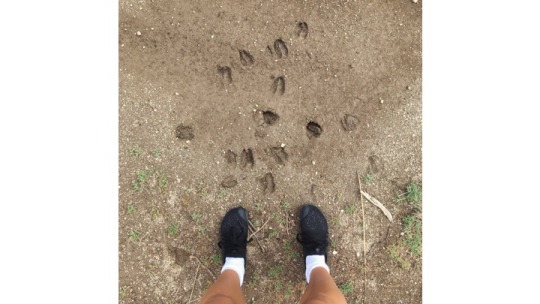
During that same visit, I came across a copy of the book Yaqui Deer Songs / Maso Bwikam: A Native American Poetry, edited by Larry Evers and Felipe S. Molina. Originally from the Río Yaqui, the indigenous Yaqui (or Yoeme) people now reside across the divided borderlands of Sonora, Mexico and Arizona, USA. I read that before setting out to hunt, their ancestors held a festive rite, enacting the wilderness world through a series of songs that address the deer, asking forgiveness for those animals that will die. Though hunting is rarely practised by present-day Yaqui, traces of the tradition remain extant in the Deer Dance, wherea single male dancer becomes the Maaso– the deer – and, wearing a stag headdress, he imitates the movements of a white-tailed deer.
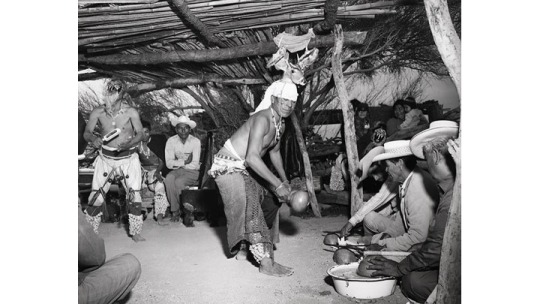
I was struck by the ways in which the photos of the costume bore a resemblance to some images I'd seen of the antlered headdresses found at Star Carr, a Mesolithic site in Yorkshire. Archaeologists have suggested that these red deer frontletswere worn in hunting rituals, allowing the wearer to harness antler effects, gaining access to the perspective of the 'animal-in-action'. Could this also be true for the Yaqui Deer Dance?
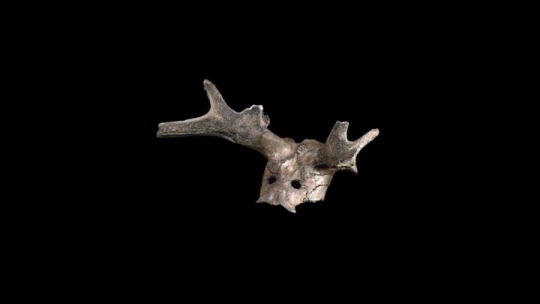
Pondering these connections, I recalled two dances I'd heard about in the British Isles – the Abbots Bromley Horn Dance of Staffordshire, believed to be a memory of a celebration of villagers’ hunting rights, featuringsix men bearing mounted antlers said to move like deer, and the Scottish Highland Fling, thought by some to have its origins in a warrior’s dance imitative of deer, with hands held aloft for antlers.
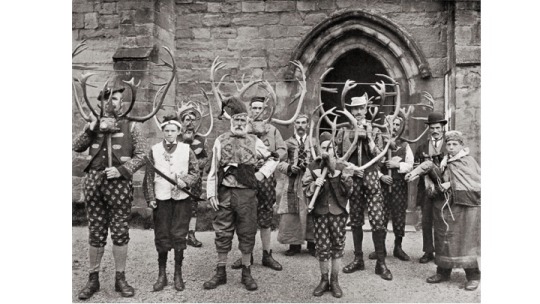
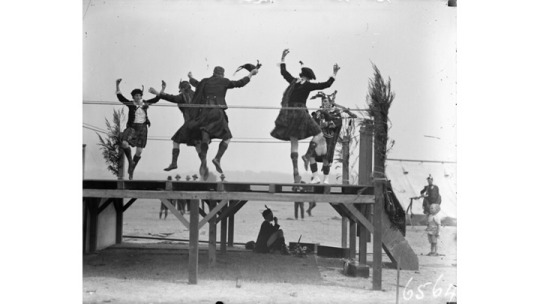
'Mimesis' – the imitation or emulation of the more-than-human-world – in traditional music and dance is something I've explored over the years, from Scottish Gaelic vocal imitations of birds, to the practice of embodying a river in South Indian Kutiyattam movement. I was keen to find out more and studythese three'deer dances' in tandem.What kind of deer effects are harnessed in these dances? Which deer behaviours are imitated and why? What do they reveal about our relationship with deer and ecology?
Over the next couple of years, I made numerous field trips to observe dances, interview practitioners, and learn steps directly from tradition bearers. Spending time observing deer, I consideredthe ways in which their behaviour is emulated in the dances and, learning about the ecologies of their habitats, I examined their relationship to hunting, stalking at Trees for Liferewilding estate in Dundreggan, and animal tracking in the Sonoran Desert. I was particularly interested in exploring the 'tacit' knowledge embodied in the dances. What could be discovered by 'learning' and 'doing' these dances, as opposed to just 'watching' them? What could be discovered in the body, through practices of stalking and tracking, instead of simply 'reading' about them?
Needwood Forest, Staffordshire...
I first went to see the Abbots Bromley Horn Dancein September 2017, and then again in 2018. This folk dance takes place once a year in the Abbots Bromley village, near to Bagot's Wood, an area of woodland just one and a half square miles, which is all that remains of the ancientNeedwood Forest. Like most forest in Britain, historically it was property of the Crown and, in this case, was once parcel of the Duchy of Lancaster.

Today the word 'forest' refers to an area of wooded land, but the medieval sense of the word referred to land set aside for royal hunting. The 'Royal Forest' included large areas of heath, grassland and wetland, essentially anywhere that supported deer and other game.Villages and towns that lay within it were subject to forest law, protecting the 'Beasts of the Chase' from being hunted by anyone except the king, safeguarding the habitat in which they lived. These 'beasts' were primarily deer, and included native red and roe deer, as well as non-native species such as fallow deer, introduced to England for the very purpose of hunting.
Every Royal Forest in England was overseen by a keeper who was appointed by the King, and whose position was often hereditary. Forest Law meant that it was illegal to hunt deer, chop down trees or underwood, unless permission had been given by the Crown. Penalties for offenses were severe, but by 1217, the death penalty for poaching had been abolished. This didn't stop some kings; during the reign of Henry VIII, a yeoman named Richard Horne was caught poaching deer in the woods and was hung for his crimes. His ghost, known as Herne the Hunteris said to haunt Windsor Forest, with antlers growing from his head and chains rattling behind him.
Within the structures of Forest Law, payment for access to certain rights became a useful source of income and local nobles could be granted a licence to hunt an agreed amount of game, giving forest inhabitants a variety of rights. As I mentioned, theAbbots Bromley Horn Danceis believed by some to be a memory of a medieval celebration of villagers’ hunting rights, possibly recalling the act of giving thanks to the local nobility for access to the Royal Forest. Others believe it was danced to ensure a successful hunt, or a good harvest. The forest itself was largely lost in the eighteenth-century due to deforestation. With all this in mind, I couldn't help but think that the Horn Dance was taking place in an imaginary landscape, in the ghost of a place that no longer exists.

The dance itself featuresten dancers: six deer-men carrying mounted antlers, a hobby horse, bow-man with his bow and arrow, Maid Marian (or man-woman) with their stick and ladle, and the fool with his pig's bladder. The antlers are mounted onto carved wooden deer heads at the end of sticks, reminiscent of a child's hobby horse toy. Surprisingly the antlers are not native; carbon dated to 1065, they came from reindeer, long extinct in Britain.
At eight in the morning, after collecting the horns from the church, the ritual begins. Moving in procession, the horn dancers exit the church yard and, on a street corner in the village, they perform a sequence of steps, circling and winding in time with the accompanying music performed on melodeon and triangle. Though stylized, particular movements are especially mimetic. Recalling the rutting behaviour of a number of species of deer, the dancers move together in a parallel walk, and then face one another, moving towards and away, passing through, as if clashing antlers during a fight. Followed by villagers and visitors alike, the horn dancers and their musicians proceed to beat the bounds of the village, walking over ten miles throughout the day, performing at each farm and pub. Taking a drink at every stop, as you might imagine, banter follows, with jokes erupting at every turn. The music is constant and consistent and, soon enough, I found myself humming along with the tunes. The sound of the triangle was particularly affecting, cutting through the cacophony of sound.

At Blithfield Hall, the tone changes considerably. The hall, a Grade 1 listed country house owned by the Baggots, has been in the family since the 14th century. The horn dancers perform on the lawn outside and when the music stops, they stand in line and wait. The Lord and Lady of the house then proceed to shake each dancer's hand, while the audience looks on from across the boundary wall. In a legacy of class inequalities, the memory of a celebration of hunting rights becomes particularly visible. Back in the village, the dancing finishes at about eight pm, when the horns are returned to the church, to be hung on display until the following year.
During the dance, I met Jack Brown, a tradition bearer and local historian, now in his nineties, who was dressed as a fool in yellow tails. He explained that he had "played all the adult parts" in the Abbots Bromley Horn Dance – deer, hobby horse, fool, man-woman and musician – and invited me to visit him at his home, a treasure trove of photos and objects, including props from the dance – a pig's bladder, triangle, bow and arrow, and stick and ladle. Jack shared with me his memories and knowledge of the dance's history and gifted me a pamphlet on his interpretation of it.
The horn dancers themselves are also very generous, opening up the floor – or ground – to participation, and over the two years I visited, I took part in a number of dances, giving me direct insight into the movements, shapes and step formations, as well as an embodied understanding of the sheer weight of the horns. Weighing between sixteen and twenty-five pounds, it is physically difficult to dance with these objects, to carry and move with them. Reindeer antlers are larger than red deer – our biggest native species – and if, as it has been suggested, they were imported from Scandinavia, perhaps we could say that the dancers of yesteryear were attracted to their size, in order to 'harness their effects'. What are these effects, I wondered? The size and weight of the antlers certainly enhances a performance of physical strength, perhaps showcasing 'heroic' abilities of endurance. During times when hunting was commonly practiced, these were presumably important attributes.
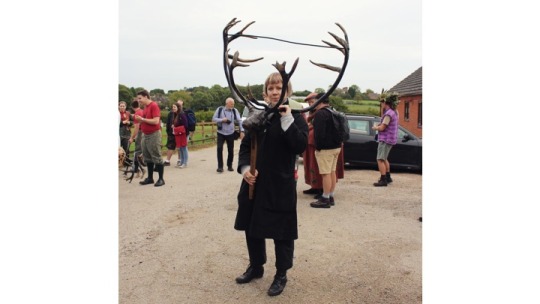
The props are most deer-like during the 'fighting sequence' when the antlers become like weapons between three pairs of rutting deer-men, albeit in an incredibly stylized rut. Some folklorists have posited that the Horn Dance was a fertility ritual; the antlers in this case would be symbolic of the male sex organ. Was this a mimetic display of the stag's bravado? Certainly, at some point, multiple powerful effects were being harnessed.
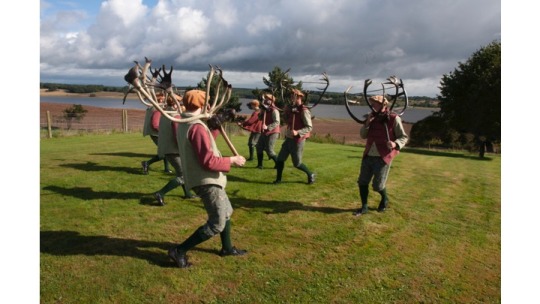
Back in the studio, I began to make sketches, tracking the shapes made on the ground by the dancers in a series of visual scores. Returning the following year, I showed my score sketches to Jack, and to Jim, a deer dancer whose family, the Fowells, have been performing the Horn Dance since 1914 after it passed to them from the Bentleys – interestingly, the Bentley family were historically the foresters of the local woodland. Checking the shapes and patterns on the page, Jack and Jim approved my visual notations, confirming their accuracy.
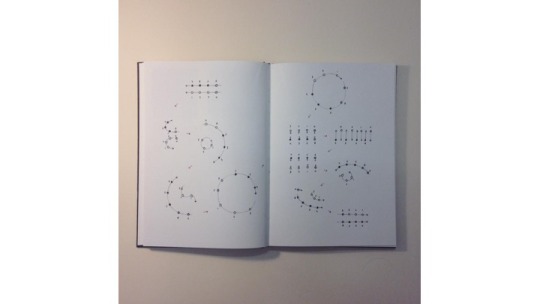
My notation process was also supported by a surprisingly fortunate booking! Reserving a room in a local B&B that looked down onto the area of the final dance, I was able to film it from above and compare the footage with my scores.
Caledonian Forest, Scotland...
The Caledonian Forest, characterised by Scots Pine trees, was once a huge forest stretching across Scotland. About 6,000 years ago, as the climate became wetter, some of the forest began to disappear, but the impact of human beings was even greater; trees were felled for ships, buildings, fuel, and to make way for agriculture. By the 1700s, the Caledonian Forest remained only in the most remote places and much of the wildlife that depended on this habitat was lost through hunting, or simply because there was not enough forest left. The last wolf is said to have been shot in Scotland in 1743, which meant that by this point, all of the predators had been wiped out. In fact, all of the largeanimals had gone, leaving only the red deer. Since then, this animal has come to symbolise the Highlands.
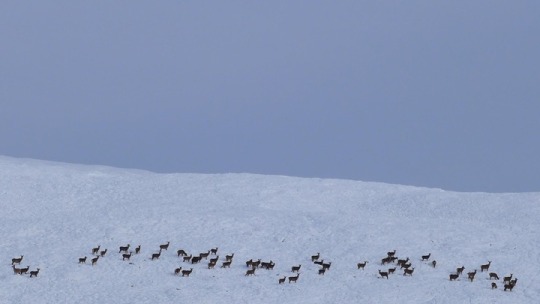
In the 19th century, as deer stalking became fashionable, large tracts of land were dedicated to deer, allowing their numbers to increase, and ‘deer forests’, which are essentially open hills managed for deer, doubled in size. Today, many Highland estates still maintain large deer populations for stalking purposes and the current number is estimated to be 350,000 individuals. Through their excessive numbers and overgrazing, deer are often seen as the problem that prevents the regeneration of the Caledonian Pinewood, however, the ecological imbalance between native forest cover, numbers of grazing deer and lack of natural predators has been caused by humans, not deer.
Trees for Life acquired their Dundreggan estate in 2008, and since then, they have been rewilding the land, planting new trees in places, such as higher mountainous areas where it is difficult for trees to establish on their own, and reducing grazing pressure to allow the forest to recover and regenerate, which, inevitably, involves the culling of deer. In 2017, I went to stay in Dundreggan, and went out stalking with Allan Common, the lead deer stalker on the estate. It was autumn, which in the red deer calendar, meant this was the time of the rut. Meanwhile in the stalking calendar, it was the time for hunting stags. I wasn't sure whether this seasonal stalking tradition was due to the fact that a rutting stag, full of high levels of testosterone, was less alert and easier to hunt, or whether it was because this hormone surge meant that the stag was now adorned with a large mane and antlers, and so more desirable as a trophy. Doug Gilbert, the operations manager at Trees for LifeDundreggan suggested that perhaps it was a mixture of the two – a legacy from the stalking craze.

Dressed in a ritual costume of wax jacket, gaiters and tweed deerstalker hat, at 7am I was met by Allan and two of his friends. Up on the hill, he instructed us to move as one body, then, as we got closer to the deer, he showed us how to lie on our bellies and remain hidden. At the edge of a ridge, we stopped to look down into a bowl-shaped area. The distant sound of roaring stags reverberated into the cold morning and, for a brief moment, through binoculars, I watched as two mature stags walked in parallel, checking each other out, before lowering their antlers, initiating contact. Throughout the morning, Allan, or one of his friends, would position a gun, then using its view finder, take a shot. Sometimes this awkward movement alerted the deer to our presence, so to counter this, Allan skilfully mimicked the bellow of the stag with his voice, to keep the stags interested. It worked! – at one point, a mature male drew very close, standing only a metre or so away. Concealed safely behind a boulder we listened to his spine-tingling roar. My heart beat fast.
While staying with Doug and his partner Joyce, a fundraiser at Trees for Life, I learned more about their work. In order to regenerate the Forest, as well as the practical task of planting trees, they explained that there needed to be a shift in values, from "seeing the land as a place for deer, to seeing the land as a place with deer in it". On the estate, it does feel as though this is happening. When I asked Allan what the biggest changes have been in his job as a stalker, he explained that it was his shift in perception; he used to think the deer were the most important thing, but now he values the land in itself, the ecology as a whole. He told me about an earlier job, working for a sporting agency, where people pay money to go shooting, but had realised some time ago, that he didn't like this 'trophy culture'. He preferred instead to have a relationship with the place, and recounted lying on his back, watching as a golden eagle flew over him, just metres above his body. His most treasured memories were not to do with stalking itself, but a connection with the more-than-human world.
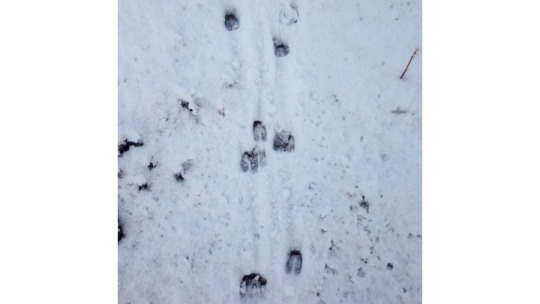
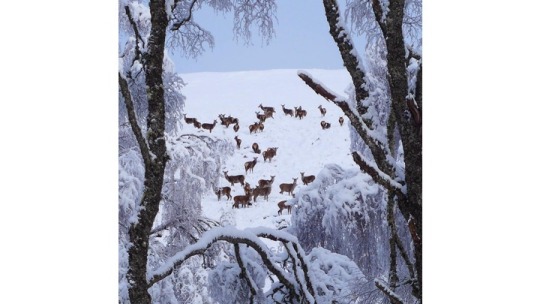
In February, when I returned to Dundreggan, there was heavy snow on the ground, and the deer tracks looked as though they had been debossed, not in earth but in thick white paper. It was the season for stalking red deer hinds, which, like the stags, were hunted in the morning. Night time was reserved for stalking the sika deer, an 'invasive' species from Japan. Being nocturnal, with a tendency to stay hidden under tree cover, they were difficult to spot. Allan used a combination of traditional tracking and an infrared thermal camera to find them. I began to reflect on the relationship of technology to the traditional costumes worn in the various dances, specifically in relation to the red deer frontlets found at Star Carr. Archaeologist Chantal Conneller has posited that these frontlets extended the body of the wearer, allowing them to "harness the animal in action", expanding their perception, essentially becoming-with-deer in order to hunt them. The user of the hunting rifle, with telescopic view finder and infrared thermal imaging also extends the body and perception, augmenting and expanding the senses, extending what is possible as a human being.
Allan may have used up to date technology, but he didn't appear to display any of the macho behaviours I had expected. His friends, however did, and on occasion, I felt uncomfortable. One ex-military friend, in particular, was keen to tell me all about his rifle throughout the stalks, even making me pose for the camera after a successful shoot. This macho sporting chat is not unusual in Scotland, in fact, it is part of mainstream stalking culture. After all, on most estates, the land is maintained as a 'wilderness' resource for deer, which supports an elite hunting economy for the privileged few – mainly rich cis white men on shooting holidays, collecting their trophies. This macho aspect of stalking is reflected in the language; the 'monarch', for example, is a term used to describe a mature stag with sixteen tine antlers, and thus the most prized trophy. Similarly, the language of animal behaviour studies is also gendered, and arguably problematic; the word 'harem', for example, is used to describe a group of female deer sharing a single mate.
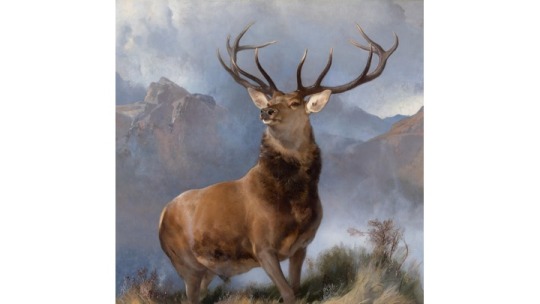
Deer stalking itself is steeped in myth and folklore. Geographer Hayden Lorimer writes: "The pursuit of deer, both as a pastime and as a livelihood, has a long history in the Scottish Highlands. Celebrations of these activities, preserved through several centuries in native Gaelic folklore, oral ballads and apocryphal yarns, were seized upon by the authors of stalking guidebooks, histories and personal reminiscences." Scottish 'deer' folklore was mined and appropriated by the cultural elite, giving deer stalking culture seeming authenticity.
The Highland Fling seems to be part of this process of appropriation. The story goes: Legend tells of a boy who encountered a stag; his father asked him to describe what he saw and, lacking adequate words, he danced the animal instead, his movements imitating capering, his hands held aloft for antlers. Becoming popular as an authentic dance of the highlands, it seems that deer mimesis gave the Fling credibility, but after some digging, I discovered that the story is more than likely a bit of 'fakelore' and probably invented by an eighteenth-century, Lowland dance teacher as a caricature of a 'wild' highland warrior who imitates deer. I couldn't help but think that this 'fakelore' shares striking parallels with the romanticisation of deerstalking, itself a mimetic performance of hunting traditions, reinterpreted and distorted into a form of macho display by landowning classes.

In Spring 2018, I began my studies in Highland Fling, taking lessons with dancer and teacher Sandra Robertson in Kinguisse. Sandra gave me a pair of leather ghillies – soft shoes traditionally worn in Highland Dance. Strangely, the word 'gillie' also means 'hunting guide' or 'male servant to a Highland chieftain'. The shoe's name is thought to be a type originally worn by Scottish hunting guides, who were servants to the lairds – there it was again: the working-class highlander at service to the landowning class and to the elite hunting economy.
I put the shoes on over my thick red socks and Sandra showed me some basic steps. Having done ballet up until the age of 19, I was accustomed to jumping, but the first thing to get used to was landing on the balls of my feet. This took some practice and on the evening after my first session, my shins were agony. Slowly, with time, I got used to it, and before long, I had learned six steps: shedding, rocking, toe and heel, backstep, crossoverand last shedding. It took me months of practice to get through the whole dance without stopping – it was exhausting! Anyone doing this dance regularly, had to be extremely fit.
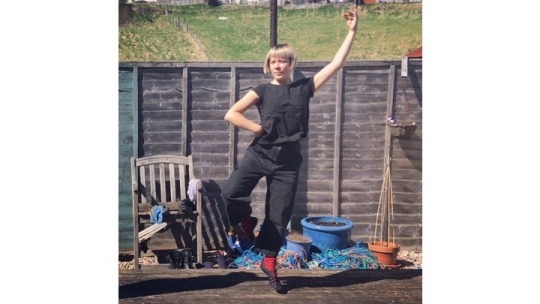
To help with my learning, I made visual scores of the dance, replacing arm positions with red deer antlers, and human foot fall with red deer tracks in a notation of the steps. I also began to experiment with blind debossing, inspired by seeing the tracks in the snow.

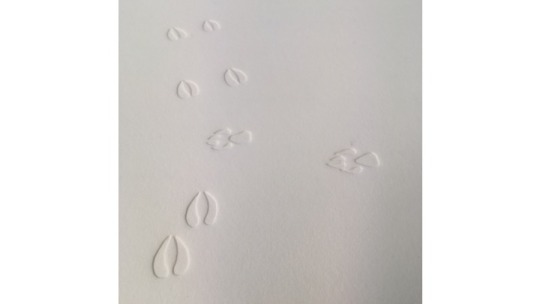
Romanticisation aside, learning the Highland Fling, I could understand why the story of deer imitation stuck. While dancing with deer in mind, the arms, when held high, felt like antlers. The steps, such as toe and heel, backstep and rocking were delicate and deer like, yet powerful and athletic. Two of the steps sheddingand last shedding seemed even to reference the stag's antler shedding, which happens once a year. I could imagine that if a dancer of the Fling performed well, it might make them feel powerful and elegant. I wondered how it might feel to perform this dance if I were a man?
Sonora Desert, Arizona and Mexico...
The indigenous Yaqui, or Yoeme tribe are originally from Sonora in northern Mexico. Seeking refuge from persecution by the Mexican Government in the 19th and early 20th centuries, some of this community were forced north of the border. Their descendants in the USA call themselves the Pascua Yaqui, and in 1978 they were finally recognised as an official tribe. Today, the Pascua Yaqui have eight communities in Southern Arizona.
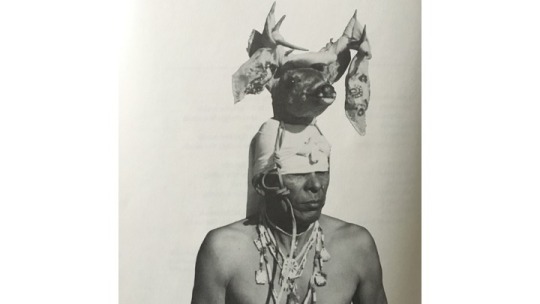
The Yaqui Deer Dance is a small but important element in the modern Yaqui ceremonial cycle, a ritual involving dance, music, pantomime, and poetry, in a complex blend of catholic and indigenous beliefs. Yaqui traditions speak of the Deer Danceonce being part of a rite performed before the hunting of the deer, but today that connection is only a memory.
Supported in part by the University of Arizona Poetry Centre, in March 2018, I went back to Arizona to begin to make connections with the Pascua Yaqui community. I met with Larry Evers, who co-authored the book on Yaqui Deer Songs mentioned earlier. He was about to retire from his role as a professor between the English and American Indian Studies departments at the University in Tucson, and when I visited, he was clearing out his office. Generously, he gifted me a pile of books and papers on Yaqui culture, as well as a set of DVDs with hours of footage of a Deer Dance ritual performed in Mexico in 1976. Of particular relevance to my research was an old type-writer written thesis, in which the writer Susan Burton explores the relationship of the Yaqui Deer Dancesteps to the movements of real deer and, using the 1976 film footage, notates the dance's vocabulary with labanotation.

Larry was excited by my research, though warned me that I would have many boundaries to cross. Firstly, my gender – the Yaqui Deer Danceis strictly a male domain – and secondly, my ethnicity as a white European. As with many First Nations people, the Yaqui tribe have been consistently ill-treated by various outsiders throughout history, from the invasion of the Spanish Jesuit missionaries and the Mexican Government's persecution of indigenous tribes, to the early American anthropologists misquoting traditions, and the US authorities' mistreatment of anyone who is not white. Understandably, the Deer Dance, and Yaqui culture more broadly, is rarely discussed outside the community.
I was readying Donna Haraway's book 'Staying with the Trouble' and the following passage resonated:
"Indigenous peoples around the earth have a particular angle on the discourses of coming extinctions and exterminations of the Anthropocene and Capitalocene. The idea that disaster will come is not new; disaster, indeed genocide and devastated home places, has already come, decades and centuries ago, and it has not stopped. The resurgence of peoples and of places is nurtured with ragged vitality in the teeth of such loss, mourning, memory, resilience, reinvention of what it means to be native, refusal to deny irreversible destruction, and refusal to disengage from living and dying well in presents and futures."
I wondered if it was possible to foster a meaningful dialogue and cultural exchange? To open up possibilities, Larry put me in touch with his long-term collaborator Felipe Molina, a Yaqui tradition bearer, teacher and translator, from Marana, Arizona. We exchanged emails and, though Felipe was interested in my research, he was too busy with his Easter commitments as a Deer Singer. We agreed to be in touch again later in the year.
During the Easter ceremonies, the Yaqui Deer Danceis held on two occasions, at the Pahko– an all-night Fiesta – and then again on Easter Saturday. Seeking permission to attend these, I contacted Daniel Vega from the Language and Culture Departmentof the Tribal Council at the Pascua Yaqui Reservation. At our meeting, I explained how I was exploring the imitation of deer across cultures in order to better understand their relationship to ecology and, sharing a little about my research so far, I was delighted when he showed a particular interest in hearing about the Abbots Bromley Horn Dance. He explained that the Yaqui tribe perform their various ceremonies as healing rituals, not just for the Yaqui, but for everyone around the world, so, if I went with respect, I was welcome to attend the Easter ceremonies at Old Pascua– the old village in South Tucson. He warned me not to take photos, make sketches or any recordings – this was strictly forbidden – and that I had to keep my cell phone out of sight.
Not quite knowing what to expect, on Friday evenings I began to attend the Lenten ceremonies, participating in the processions of the fourteen Stations of the Cross, following the various church groups who sang and prayed at each of the crosses positioned around the Old Pascua village. Also partaking in the processions was a ceremonial group called the Fariseos, who are said to represent those who persecuted Jesus. Within this group were the Chapayekas– masked figures who symbolise evil. One of the Chapayekas'ritual functions is to deride the procession and distract the church groups by silently mocking them, beating time with swords and daggers, and shaking the deer hoof rattles around their waists and moth cocoon rattles on their ankles. My initial reaction was to laugh at their pantomime-esque performance, but as the sun went down and the procession continued in darkness, they really felt quite sinister. I soon discovered that it is taboo to stare too closely at a Chapayeka.
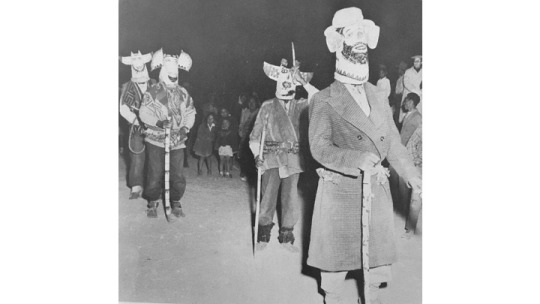
On Palm Saturday, I attended the Yaqui Pahko. Though I'd read so much about it, nothing could quite prepare me for the experience of this multifaceted, powerful night-time ritual. Approximately two hundred performer-participants, divided into about twelve groups, each with a distinct role and music, carried out ritual processes and costumed dances representing the various overlapping forces of good and evil. There was only one Deer Dancer though; at the Ramada, a structure symbolising Huya Ania (the wilderness world), the Maaso(the deer dancer) emerged as a timid fawn and, dancing alongside the Pahkola(a group of clown-like animal-esque figures), he slowly grew into a virile adult male through the night, before predicting his own death and concluding his dance as an animal spirit.

During a break in the ceremonies, I chatted with someone I'd met in the 'audience' who made a striking observation about how the Maasoalways has his torso tilted forwards, like the enigmatic Palaeolithic ‘sorcerer’ cave painting of the Trois-Frères caves in Southwestern France. I hadn’t made the connection before, though I had stuck an image of the ‘sorcerer’ in my sketchbook. The visual similarity is uncanny – was this how humans become-with-deer?
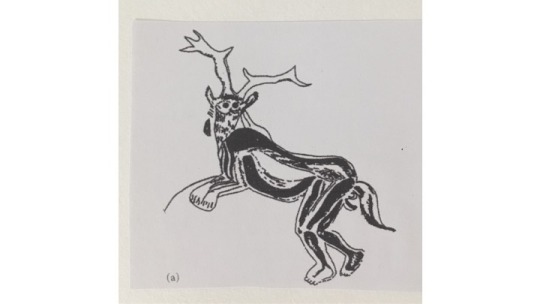
A similar sequence of Deer Dances took place on Easter Saturday, another complex, multi-layered ceremony, where, in a battle against evil, the powers of the more-than-human world were harnessed. Dancing Matachiniswore flower streamers in their hats, processing Angels waved branch-switches in the air, trickster Pahkolas wore animalesque masks, and, the Maaso (Deer Dancer), in his final dance, charged at the Fariseos, threatening with his antlers. Finally, when evil was defeated, the Fariseoswere ritually ‘killed’ by 'flowers', symbolised by paper confettithrown at them, and a straw ‘Judas’ was burned in a fire, along with all the Chapayekamasks and swords. Bells rang out from the church and celebratory music was played. With so much colour and joy, I felt like I never wanted to brush the confetti out of my hair!
In a closer examination of the Deer Dance itself, the combination of the dancer's movements and costume seems to span a spectrum of mimesis, from iconic deer imitation to something more stylised. The deer's headdress enhanced the sudden sharp-to-still deer-like movements of the head; soon enough, I found myself watching not the dancer's eyes, but the deer's eyes, partially hidden beneath the cloth. The long line and tension of the tilted torso suggested a deer's back, and the white cloth joining the dancer's head and deer head gave the impression of a deer's neck and shoulders. The flexed feet were reminiscent of the animal's hind legs, while the gourd rattles suggested the front legs, the movements of which gave the impression of a deer's speed and agility. The footwork itself – the choreographed steps – seemed less iconic and more stylized. I wondered if I would be able to meet and learn from a dancer some time...
The dance is traditionally accompanied by three musicians who sing and play instruments: the hirukiam,notched rasping sticks resting on half-gourd resonators said to represent the deer’s breath or the scraping of the antlers against the brush, and the ba’ abweha’i, a water drum made from a half gourd floating in a bowl of water, representing the heart-beat of the deer. Sitting on the floor during the dance,I could feel the vibrations of the water drum in my chest, and I imagined that the dancer might be tuning his heart into a deer's heart beating.
The songs accompanying the dance, are sung in Yoem noki(the Yaqui language) and describe the Maaso(the deer) and his encounters with other animals, birds, insects and plants, especially flowers, which hold a spiritual significance. The Yaqui believe that there is a close communication between all the inhabitants of the Sonoran Desert, which they call Huya Ania. This could be translated as 'wilderness world', but it is worth pointing out that the word 'wilderness' here, does not mean a "neglected, uninhabited, or inhospitable region" like it does in the Oxford Dictionary, but a living, connected community. This ecology of the Sonoran Desert appears in the traditional songs, which become like scores, or a script to the dancer who, as the deer, also becomes, for a moment, the badger that is being described, or the hummingbird, or the mountain lion.
Later that Summer, I returned to meet with Felipe and, over a number of meetings, learned more about the dance. We shared our perspectives and he generously answered my sprawling questions, teaching me about aspects of Yaqui culture, including some Yoem nokiwords. Felipe explained how the Deer Dance was a way for people living in the city to connect with Huya Ania (the wilderness world) and Sea Ania (the flower world), and as he described how the songs are lessons for listeners to learn about ecology and Yoeme ancestors, I began to think of the Yaqui Deer Dance as a form of activism.
I was honoured when Felipe invited me to give a talk to his students, a class of young Yoeme adults, who were learning about their culture at the Yaqui tribal chambers on the reservation. I shared a little about my work with vernacular traditions, specifically Scottish Highland culture and language, and about the history of the repression of Scottish Gaelic and the current resurgence of the language. It was good to hear Yoeme perspectives. Though the Yoem Noki language is under threat of dying out, people like Felipe are out there doing the work of preserving and passing on knowledge.
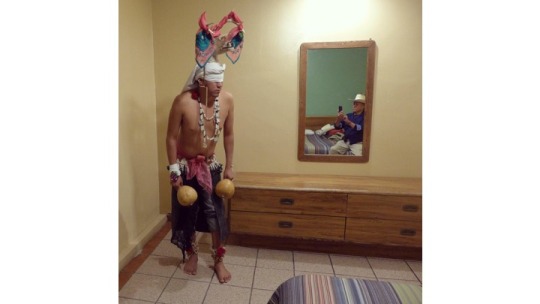
Felipe and I began to make plans to visit a Deer Dancer in Mexico later in the year and, in November, over a number of days, we went back and forth by foot across the Mexico-USA border, to work with Indalecio ‘Carlos’ Moreno Matuz, a young Yaqui Deer Dancerfrom Vicam, Sonora, in the Yoeme homeland. We worked in Carlos’ hotel room, where I interviewed him and learned about the physical and symbolic aspects of the dance through demonstrations and diagrammatic drawings, while Felipe translated from English to Yoem Noki and back again.

Felipe and Carlos explained that the dance had only ever been performed by men because they were the ones who traditionally went hunting. Interestingly,the deer behaviours imitated were less about the bravado and display associated with the rut, and more about alertness and agility as a form of defence. This corresponds with the fact that in Yoem Noki, there is no word for 'buck' or 'stag'; Maasosimply means 'adult male deer', though his other song names are displayed here. The only time the Maasodisplays aggressive behaviours, such as charging or threatening with lowered antlers, is when he is being attacked or provoked by other figures in the ceremonies.
The white-tailed deer – and coues-white-tailed deer – live in areas of the Sonoran Desert – a land that rambles over 320,000 km, across two countries. It is home to about 130 species of mammals, more than 500 kinds of birds, 20 amphibians, 100 or so reptiles, 30 native freshwater fish. There are perhaps as many as 2500 native species of plants and 4000 in total. It is also home to at least 17 Indigenous cultures as well as many others who have adopted it.
The tribal lands of the Yaqui have been irreversibly damaged, initially due to the European invasion and colonisation, and latterly by the rapid growth of capitalism and climate change degrading the ecology. Along the Yaqui River in Mexico, eight tribal villages have no water due to drought and the actions of agricultural corporations and, every year, people battle with wild fires caused by rising heat levels and invasive grasses spread by cattle. Although the culture of the Yaqui Deer Danceis being preserved, the ecology of the wilderness world is seriously under threat.
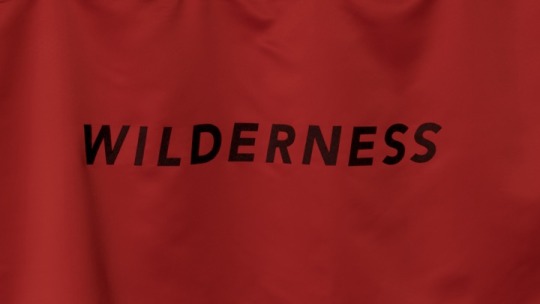
Wild-deer-ness
Throughout the process of exploring these dances, I considered how a body of work might emerge from my research. By conjuring the antlered male deer, the dances evoke images of wild nature, but I realised there is a disconnect between what is encoded in their movements and the reality of local ecology. I was also acutely aware of the striking relationship between our cultural perceptions of 'wilderness' and ideas of 'masculinity'.
How could I honour these folk traditions and histories, yet simultaneously critique and de-stabilise constructed problematic narratives? How could I address contemporary intersections of ecology, gender and class? How could I touch on the complex relationship between indigenous cultural knowledge and the appropriation of vernacular culture? What did I want to explore and communicate?
I spent time writing, thinking, dreaming and in my note books began to distil my research into words:
From Palaeolithic cave paintings, to Landseer’s Monarch of the Glen, throughout time, artists have made representations of deer. Whether as staples to hunter-gatherers, icons of power and empire, or the focus of sport, deer have long been central to human cultures.
In popular imagination, deer remain etched into people’s consciousness as emblems of the 'wild' – the word wildernessitself, derives from the Old English wilde, wild, and doer, deer – and our relationship to the idea of wild-deer-nesshas shaped the landscape. Transported across continents, some species, such as fallow and sika deer, transformed ecologies with the establishment of royal deer forests and parks – hunting grounds belonging to the Crown. Other species, such as the reindeer of the arctic tundra and white-tailed deerof the Sonora desert, face threats of habitat loss caused by climate breakdown. In Scotland, the overpopulation of red deer due to human made environmental change impacted greatly on the degradation of Caledonian pinewood ecology.
And so, it follows, although they are perceived as powerful, deer also embody vulnerability. Constantly alert to the threat of a hunter or predator – or the ‘ghost’ of an extinct predator – they inhabit vulnerable places. It could be said that deer do not live in wilderness, but in ghosts of places that no longer exist.
Across timescales and cultures, our relationship with deer as a totemic and ideologically powerfulanimal has contributed to a construction of wilderness as an imaginary landscape, setting 'nature' apart from 'culture'. Is it possible to shift our relationship to the world and renegotiate these dichotomies?
The dancers at Star Carr, the Abbots Bromley Horn Dance, the Yaqui Deer Dance and the Highland Fling are separated by geography and time, yet there is a commonality in these seemingly disparate cultures, which find echoes throughout history, fromthe ritualised carrying of stag heads condemned by medieval European church leaders, and Herne the Hunter, the antlered ghost of a royal gamekeeper in English folklore, to the Tibetan stag-headed Chamdance and Shishi-Odorideer dance of Northeast Japan.
Evolving over generations, each dance is mimetic in some way, with movements that imitate male deer behaviour and gesture, from the frolicking of the fawn and the alertness of the adult male, to the bravado, display and aggression of the rutting stag.Costumes also play a significant role, and often, but not always, feature elements of attire made from animal parts. Another common feature is that they are (or were) traditionally performed by men and, with their displays of muscular strength and athletic endurance, they are all thought to have their origins in (or associations with) hunting ritual practices.
As traces of hunting rites, how are these dances to be understood within a contemporarycontext?
How does the mimesis of male deer behaviours inform a 'performance' of masculinity by male dancers? What are the implications of these gendered performances in society today?
Returningto the animal tracks that obsessed me, back in the studio, I finished scoring the three deer dances I had studied, tracking the steps of the dancers, replacing human foot-prints with deer hoof-prints: red deer for the Highland Fling steps, white-tailed deer for the Yaqui Deer Dance steps, and reindeer for the Abbots Bromley Horn Dance steps. Working with Edinburgh Printmakers, I developed these into a series of blind debossed prints.
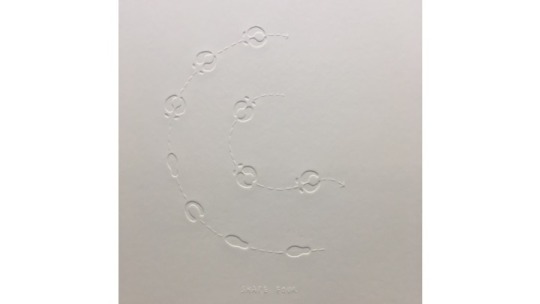
Becoming-with-deer
Considering different approaches to choreograph from the scores, I decided to draw upon the most mimetic aspects of what I had learnt and adopt fragments of steps to make something entirely new. But who would perform this? Drawing on multiple layers of my research, I began to conceive of a series of characters, each one a constructed assemblage of aspects drawn from a male-deer/male-human spectrum, playfully dissolving human:animal binaries. Making sketches of these figures, I gave each of them names borrowed from archetypal male characters found within traditional theatre, as well as deer and deer stalking terminology: monarch, warrior, young buck, fool and old sage.
To get to know them with my body, I decided to attempt to become each deer-man myself. By queering these figures, I hoped to challenge our constructed ideals of masculinity and question the mythologies that give authenticity to gendered behaviour. Having experienced some of the more negative and toxic behaviours of the heroic-hetero-male in my day to day life – let's call this thecrisis of masculinity– I also wondered if, by becoming these characters, I could release myself from their impact on me as a queer woman, and simultaneously bring to the foreground the impact of these behaviours – the crisis of ecology– on vulnerable and damaged habitats.
My plan became to create a moving image and sound work, performing each character in a choreography-to-camera. I began to collaborate with two performance artists: Peter McMaster and Will Dickie, who both practice at the intersection of live art and dance, and whose past work had, in various ways, explored tropes of masculinity, ritual and ecology. Peter collaborated with me on the film's dramturgy and Will became the movement director, helping to devise the choreography. Together, we discovered and developed the characters.
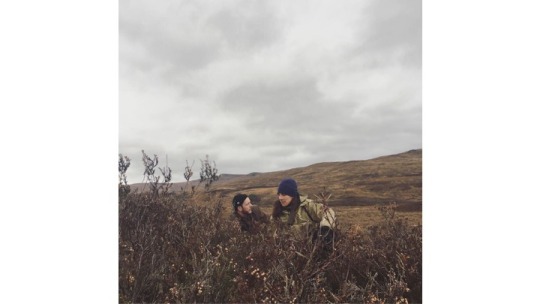
To begin our process, in October 2018, we spent a few days at Trees for Life, workshopping ideas and watching deer. We also went out deer stalking with Allan. This time I was very sensitive to his movements, almost reading him as a dancer, and was struck by the ways in whichhe took on qualities of the animal of the hunt, harnessing deer-perspective.Like the deer, he was quick to register distant movements and sounds and, on getting close to the animal, to remain hidden, he tilted his torso with bended knees, a pose strikingly similar to the Yaqui Deer Dancer's basic posture and cave painting of Trois-Frères.Will made an interesting observation about how the deer stalk appeared to be carried out in clearly defined ritualised stages. Beginning casually, walking upright and chatting, we slowly grew tighter as a pack, becoming quieter and more focused, tuning in to our surroundings and, as we drew near to the deer, we got close to the ground, not moving or making a sound, our bellies up against the heather. Before taking a shot, Allan spoke about a moment of stillness – a stillness of breath and of thought.
In a similar way, each dance that I had been studying, sat at a different stage in the ritualised drama of the hunt: the Yaqui Deer Dancetraditionally took place before hunting, allowing the hunter to access the perspective of the deer; the Highland Flingwas a dance of triumph, a dance to feel powerful and in control; and the Abbots Bromley Horn Dancewas a celebration after the hunt, to give thanks. With gestures that ranged from iconic imitation to stylized metaphor, these rituals of the hunt were clearly mimetic of the rituals of the deer rut. But how could the dramaturgy of my film address what felt urgent to me: the interconnections between the crisis of masculinity and the crisis of ecology? We slowly began to realise that if Deer Dancer was to function as a ritual space, perhaps the characters would have to stalk each other to the death...

Early the following year, Will, Pete and I worked together to discover the five characters from the inside, developing their movement vocabulary and training exercises and, as we explored the relationship between them, a story emerged. I began to conceive of a two-channel film and sound work that would play with, and attempt to destabilise narratives found both the within anthropology documentary and wildlife/nature documentary. To prepare for the filming process, I created a story board for the two screens, and composed and recorded a multi-layered vocal composition to perform to.
Utilised technology to 'extend my body' and expand my vocal range into 'male' and 'stag' pitches, I worked with my voice to imitate drum sounds. Recalling my experience of the Yaqui water drum, and the Abbots Bromley Horn Dancetriangle, my intention for the sound was to affect the viewer-listener on a body level, sometimes in a way that is unsettling, at other times like a heart-beat of low vibrations in the chest or belly. Alongside the process of developing the characters physicality, and the vocal score, I began to design and make the costumes and props, with invaluable assistance from my partner Lydia Honeybone, using an assemblage of materials, from ribbons and sequins, to bullets and hunting horn. I also worked with naturally cured deer hide, hooves, antler and skull, specifically for the cod pieces, and the weapons, hinting at the relationship between the posturing of male sexual bravado and violence.
We filmed over three days in Glasgow University's theatre against a black curtain. My director of photography Andrew Begg lit the space, and followed the story board shot by shot, filming each character one by one, then, in post-production, with editor Laura Carreira, I then pieced together the jigsaw puzzle.

Introducing the characters...
The Monarch is a mature, dominant male, who holds his head high, displaying his sixteen-tine crown and enlarged neck. Over his hide, he wears gold. His stance is wide and a bulbous codpiece with tassels enhances his majesty. Belling loudly, he asserts his authority, warning off rivals to his harem of hinds. But he's growing old and his limbs are becoming stiff. Soon he'll be past his prime.

The Warrior is highly alert, his senses tuned into his surroundings. He tracks and hunts, defending himself on attack with antlered spears that extend from his shoulders. He's in his physical prime; his chest is hard and strong and over his tartan loins, he wears a sporran and bullet belt. When he hears his rival, he sounds his horn, displaying his power.
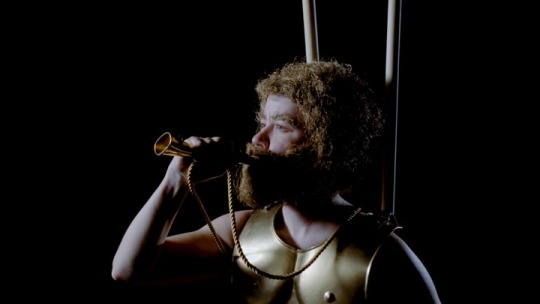
Though the Young Buck has reached sexual maturity, he's still a spiker, yet to win his own harem. But he's looking. Dressed in tweed trews and protruding codpiece, he taps the ground, addressing potential rivals. He is lustful, cocksure and trigger-happy, challenging anyone in his close proximity. Breathing heavily, he's on the hunt for a hind, on the hunt for a fight.

The Fool, small in stature, avoids the dominant males as they proclaim their authority during the rut, bawling and displaying his white behind in fear. Wearing ribbons, bells and a modest codpiece, he carries a broom with antlers, a hobby stag that appears to push and pull him into combat. Haunted by ghosts, this skittish staggard is bewildered by his own inner conflict.
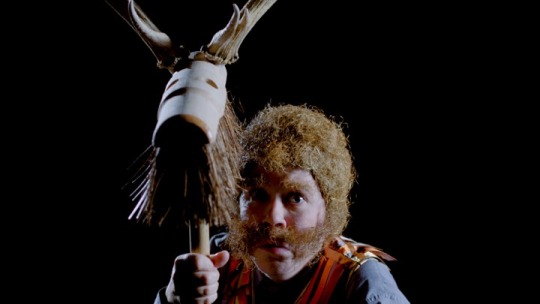
The Old Sage is a spirit of the wild hart and ghost of a man. Haunting the wilderness with skull and ragged horns, he relives his life tending the land with hooves and hands. He also relives his death. Only perceived by a few, he sees all.
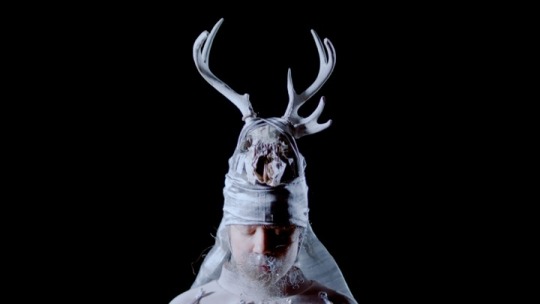
Deer Dancer
In the resulting work, the costumes, movements and music work together to tell a story, with the visual scores acting as hidden keys to the work. In the 'pop up theatre space' of the gallery, we meet the five characters in an imaginary wilderness world. This wilderness world is not rooted in a particular ecology, but is place-less, black and empty, allowing the viewer-listener to construct and project their own wilderness into the space.
A dynamic emerges between these deer men, and slowly they begin to stalk one another.Then, in a face-off, they lock eyes, take a bow and the deer dancecommences. With movements that signify both the deer rut and a pre-hunt ritual, the characters face one another, performing their ritual dance, with fragments of steps from the three dances. In the visual scores, these steps are delinieated in gold foil on the debossed tracks – interestingly, the word 'foil' also means 'animal track'.

Then, coming to a stop, one by one, the deer-men draw their weapons, and we see each one lying in their death pose, with blood flowing from their body, signified by slow moving red ribbons. As bodies disappear (or decompose), the costumes remain as relics of culture to be performed again. Bit by bit, they too disappear, until then reappear on my body, piece by piece, reconstructing each character in a queer assemblage. And then it begins again...
Stuck in a perpetual loop of learned behaviour and appropriation, these stag-men are ultimately condemned to self-destruct. Humankind has left a footprint so deep that we are only now beginning to grasp the immensity of the calamity. In a small way, I've come to think of Deer Dancer as a contemporary life-crisis ritual for a damaged planet. But when the balance has been set right in ritual, the question becomes how do we really address the damage?
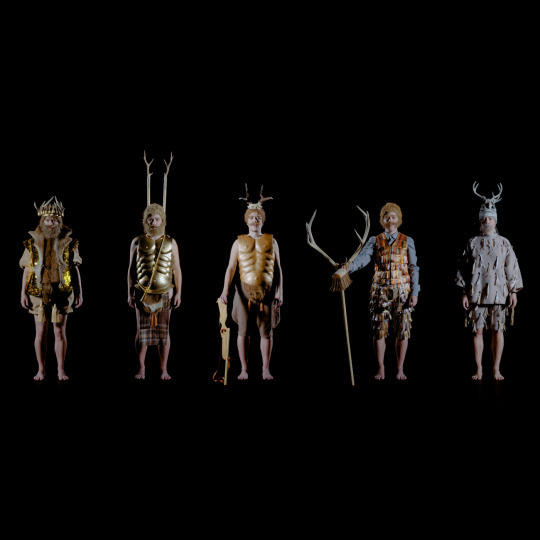
This text was originally written and presented as a talk at Edinburgh Printmakers in September 2019, to accompany Tuulikki’s Deer Dancer exhibition.
Deer Dancer credits: Performed & directed by Hanna Tuulikki; Character development and choreography by Will Dickie, Peter McMaster and Hanna Tuulikki; Dramaturgy by Peter McMaster; Movement direction by Will Dickie; Sound composed and recorded by Hanna Tuulikki; Sound mixed with Pete Smith; Director of photography by Andrew Begg; Edited by Laura Carreira; Costume fabrication assistance and wardrobe management by Lydia Honeybone; Production management by Amy Porteous; Costumes and print works by Hanna Tuulikki
Developed through conversations and interviews with tradition bearers and academics, Felipe Molina (Yaqui tradition bearer/ translator), Larry Evers (American Indian Studies, The University of Arizona), Jack Brown (Abbots Bromley Horn Dance tradition bearer/ historian), Doug and Joyce Gilbert (Trees for Life); by observing a number of dances and participating in rituals, including the Yaqui Deer Dance (Pascua Yaqui Easter ceremonies, Old Pascua, Tucson, Arizona, March 2018), Abbots Bromley Horn Dance (Abbots Bromley, September 2017/2018); and direct learning with Sandra Robertson (Highland Fling), Indalecio 'Carlos' Moreno Matuz (Yaqui Deer Dance), Gary Faulkenberry (animal tracking, March, July 2018), Allan Common (deer stalking at Trees for Life, Dundreggan, autumn 2017/2018).
Commissioned by Edinburgh Printmakers, funded by Creative Scotland. Research and development supported by Magnetic North's Artist Attachment, funded by Jerwood Foundation and Creative Scotland. Additional support from Hope Scott Trust, The Work Room, University of Arizona Poetry Center, Trees for Life, University of Glasgow, Glasgow School of Art, and CCA: Centre for Contemporary Arts, Glasgow.
16 notes
·
View notes
Text
13th of March, 2020
"The One with V's Sister"
[REALLY LONG ONE. I got her back for a day, you best believe I'm savouring every single goddamn second.]
Shenanigans below the cut:
Another day, another ponytail. :-)
I dreamt with her again the night before. We were at this school event and I introduced her to my Dad. As they shook hands, Dad was wondering where he'd heard her name, then asked me if she was the one I always kept talking about. V just chuckled and said that I am her best student, but I never tell her stuff like that. Dream-me was probably blushing profusely.
Right. So. Morning. Bandana Friend and I were at the secretary's office to ask for something and lo and behold, there's V in her usual seat turned towards the door, hands glued to her phone, hair pulled back. I got really excited. I had two whole classes to drink in the sight, and I simply couldn't wait. "Whoop, there she is!" Bandana Friend told me. "Yeah, I saw her. And her hair is up!" We got excited, then remembered we said it loud enough that she could've heard. A laugh was had.
After that encounter, I was informed that we were to write a pretty important test in V's class that I didn't even know about. I tied my hair back as well, and spent the whole of my History class rather anxiously cramming anything and everything Grammar-related. Class ended, and my classmates were pleading with me to try and convince V to postpone the test a little, because she likes me. (It's not worth much, though. They say that about every teacher.) I told them that even though she does, she wouldn't listen to me, either. "There's no getting a plan out of that woman's head," I said.
Turns out, I was once again boo boo the fool. V decided to axe the test and have us write it a week later. I could've kissed her. I actually went: "MISS!" out loud from the surprise, hands thrown up in the air. And not only did she axe the test, she told us exactly what to expect and what we need to know, when we eventually DO write it. And, even though we'd previously discussed everything she mentioned, she took the time to go through everything once again, explain every important thing one by one. And she spoke English again! Okay, it was one word, when she brought up euphony, and said how everyone says German is a violent, angry language because of its phonetics, and brought up the classic "butterfly/Schmetterling" example I'm sure most of you are familiar with.
As she was talking about stylistic value, and how it can differ depending on the context, she brought up the very word she called me the last time we shared a walk, the one I translated as 'babydoll'. I immediately started smiling. Pleasant memories. And, as she went on, now talking paradoxes, she brought up the epigram I associate with her. Odi et amo. I looked away from her with a bittersweet smile. I couldn't believe this was actually happening. But the rest of the time, I couldn't keep my eyes away when I wasn't writing. There was always something to look at. Her hair, her eyes, her smile, her coffee mug necklace, her outfit and body (*cough* low-cut T-shirt *cough*) and basically everything. Cynical Twat (who no longer sits behind me) had his eyes on me for a while, while I was looking at her like she hung the stars. I think he's onto my ass. Fuck.
We also spoke about the other class in our year, as they came up. I asked V if they were ahead of us, as she said she keeps mixing up what she discussed with us and them, and she told me we were basically even at the moment. Then came the obvious question from Blond Boy in the Back: who does she like more? V was very reluctant to answer that, not wanting to generate tension between us, and only wound up saying that we were a lot more disciplined while the other bunch act more freely, and that she likes them and they'll mature someday. She also mentioned she has class with them in really unfortunate time slots and that not even the best class would want anything to do with her or her subject in 7th/8th period. I was about to protest, but I remembered it would be best not to. It's not like she'd respond, anyway.
Towards the end of class, we practised recognising different types of symbolism in poetry. There was this one about tree branches throwing black bouquets on the ground. I wondered what it meant — exactly until the very moment V asked us what it meant. That's when I realised it referred to shadows, and said it immediately. V didn't look at me, just pointed at me as she repeated my answer. She didn't have to reach far — she was standing right next to me. It was quite the common occurence in that very class, as she kind of alternated between standing at the board and by my side. Brb, gotta go get my tinfoil hat.
I also remember the two of us (ft. Comparison Boy I think, but mostly just V and me) having a short debate about whether or not this one famous poem was picture poetry or not. We were so persistent that V ended up telling us something along the lines of "Okay, it can be viewed as such, but technically, it isn't." Ha! Success :)
At the end of class, just to get a proper conversation out of her, I trotted up to her to ask if the definitions of metonymy and synecdoche I jotted down for myself after a bit of extra research were passable. She said that she'd word them a little differently, but technically, they were passable. Cool. End of story.
...at least I thought so. But more on that later.
She gave us back our earlier tests, one Grammar I fucked up here (I only got a B for it, my perfectionist ass can't take it), and the Literature one from here. A+. Huh. And, for once in her life, V actually signed a test! (I'm not exaggerating when I say I've never seen her signature in the past, nearly 2 years.) But what was best, is that when we looked at Debate Friend's test, couldn't finish her essay and barely wrote anything, under it stood, in red V-cursive: "I know you ran out of time." You guys, she gave her maximum points for it! We were full-on gushing when we saw it. Angels walk among us, I tell you.
Later, I had a splitting headache in (foreign) English, and told Curly Friend that I probably would suffer through my upcoming last class of the day if it wasn't going to be with V. I think I told her I always go to V's classes to catch a break. Not because they're easy, but because I can relax and listen to things I love hearing about, from a woman I love listening to. He told me that V was feeling pretty poorly, too (he had double class with her after she was with us), which surprised me. Aside from one story she told us about her dad (she mentioned both her parents today which she doesn't usually do), she was rather very smiley and energised from the very start of class with us. The only time I saw her be more serious was when I spoke to her after class. There was something about her eyes I noticed, but didn't think much into it. The usual sharp-cold fox eyes (I thought it through, they're more fox-like than cat-like), piercing right through the soul upon first glance. Now I realise how tired she must have been.
7th period Literature, aka where things genuinely started getting crazy. Whew. Here we go. Just before we actually got started, my homeroom teacher showed up and called V outside for a minute. You'll later see why. Then, class proceeded as usual. V set up everything, then put on a video about romanticism era here, at home. But, as per usual, V couldn't stop herself from making notes on the board and pausing the video to add her own commentary. Most of the time, she was crouching beside her laptop, with a complete disregard to me looking at her instead of the video whenever she did that. Once the video was over, she explained some things, her back against the board. She realised she got a whole person's name wrong, and, upon noticing she smudged the writing a little, she remarked "I hope I wiped the board with my hair again," and reached for her ponytail. I was laughing to myself. What do you mean again, love? My dearest, the train wreck.
Second video, about this play based on a queen's assassination in the medieval times. V said it was a tragedy, and asked us what a tragedy was. As I was trying to lace my thoughts together, I did notice that quick look she stole at me that basically said "Come on, Specs, you're the drama expert, say something or this is gonna get really awkward." Me and this other boy did manage to answer, though. After that, it was video time. V took a seat on an empty desk at the other side of the classroom, so she wouldn't block the view. Coincidentally, I had perfect view of both the screen and her. And that's where everything started getting mad.
She noticed. As I was watching her reactions, she turned to me and looked me in the eye before turning back to the video. And after that, though I didn't dare to look at her as much, most, if not all my gazes were returned. When the title character eventually stabbed the queen, she let out this extremely ridiculous scream straight out of a cartoon (well, they WERE cartoon silhouettes after all). I look at V, she looks back at me with this smile of "yeah, I know". Thing is, even in the next 'scene' with a trial, taking place presumably days later, the queen's body was still on the ground. I couldn't help myself, and asked "And they just left the queen there?" V burst into a grin as she looked at me to say "No!". This time last year, I used to get very Done™ looks for this kind of joke, and no verbal response at all. We're getting somewhere, ladies and gentlemen and enby people.
After the video ended, I actually raised my hand this once, to point something out. V was about to start speaking, but said "Yeah?" when she saw my hand up, dropping that train of thought immediately. I talked about how ironic it was that only the queen and her brother's silhouettes were black, and the rest of them were white. As I thought, it symbolised who were meant to be the good guys and the bad guys. I also brought up chess, which V agreed to, and I could see she was glad that there's someone who actively pays attention to detail.
I said it was mad before? Whoo, boy, then it's about to get insane.
Class ends, and V is packing. I was standing there anyway, so I thought I'd help a teensy bit, putting the projector cable away for her so she only had to deal with her laptop. I got a "Many thanks" for it when she noticed. And then. Oh, then. I'm standing beside her desk, not saying a goddamn word, and she, completely unprompted, starts talking to me about the play in depth. She didn't even call my name to get my attention, because she knew I'd be listening. (Been there, done that.) She told me that she finds the plot interesting, and as an adult, she can appreciate it, but the whole thing is written in such a dry and complicated way (she frowned saying this), that she can't help but have mixed opinions about it.
These are all things she mentioned in class before and needn't have repeated, but I was kinda glad she did. I let her talk, adding my own opinion whenever I felt like it, drinking in the fact that she wanted to talk to me specifically about it. I told her that as an actress, I find the characters interesting and I'd love to do this play because the plot really does sound interesting. The look she gave me... she looked me in the eyes, not a word said. It wasn't the fox eyes, it felt more like she was focused on me. There was a depth to it, a silent intensity. I have no idea what she could've been thinking, but I think she might have tried to imagine it. "We'll continue this on Tuesday." she told me, as the bell was about to ring. Lmao, as if.
But it didn't end there, oh, no. Sorry, you have to read a little longer. When she left the classroom, I realised: "Hold on there, V, I'm not done with you yet" and immediately went after her. She walked over to Art Friend, who was writing a test outside, at a nearby table, to check up on how she's doing. Me being me, as they finished talking, and more of my friends started to gather around, I decided to check up on how V's doing. And — you guys aren't going to believe this —, for once, she didn't ignore me asking her how she was! She said that even though she wasn't a hundred percent well, she was doing fine. She didn't plan on not being at school on Tuesday, but life got in the way. (She even explained how, we goin' personal in here.) She didn't say anything when I told her to take care of herself, but I didn't really expect her to.
(From here, our topics might not be in chronological order, because I literally don't remember how it happened.)
There we were, on opposite sides of that table, facing each other directly. "Is the weather changing again, Miss? Is that why my head is splitting apart?" I asked her, thinking adults always know about the weather anyway. "Maybe. Or you're just sick and we're all going to die." she told me as she was putting stuff into her laptop bag. "Oh, great. Bright future you're predicting for me, Miss, thank you." I responded, somewhere along the lines of this. I don't remember the exact thing. "We're all going to die one day, aren't we?" "Well, yeah..." "Just think about all the times we could've died as children..." Bright and optimistic topic in the middle of a goddamn pandemic, courtesy of our very own Miss V. But me and Debate Friend chimed right in with our stories anyway. If there are two people who are ride-or-die with V's weird shit, it's us.
I remembered what happened the previous day, Comparison Boy calling me by her name. "[Art Friend], should I tell her about [Comparison Boy and co.]?" I asked my friend out loud, because I know V absolutely hates not knowing stuff. "Oh, Lord, what happened?" V asked immediately, both elbows on the table, watching curiously. See? This is why I adore teasing her. It's the reaction. "Long story short, they don't call me by my name anymore." I said, not daring to look up at her, no matter how coy I was being. Inside, I was still afraid of what she'd say to being compared to me. "Whose, then?" No going back. "Well, yours, Miss." I admitted. Immediately, I heard a "No." of disbelief, and there we were, both of us grinning at the accusations and me talking about how different we are on the inside. "[Curly Friend] found me with his theory, too." V told me, and now I was the one not believing her. I couldn't believe he told her! "What theory?" Art Friend asked. V seemed to have a hard time putting it into words so I helped out. "That she is me 10 years into the future." Yup. That's an actual theory he has. V looked a little... not withdrawn, even though she was leaning away from the table, but... awkward? But to be honest, we both were. "[Curly Friend] is nice, I like him, but if only he had this much creativity for studying..." V said, to close the topic off. Bwahaha.
At some point, my homeroom teacher came over to us when she saw us chatting, giving V's shoulder a little stroke as she walked past behind her to get next to her. I saw V crack a smile, this little, but very pleased one. Theirs is an unlikely friendship, but I stan it so much. She asked V about how Blond Boy in the Back was doing, as he was quite pale, and V said she noticed (she even asked him if he was alright) but nothing really extreme happened. After all the times he'd disrespected her, it's amazing how much V still cares about him. Then, my homeroom teacher mentioned a potential new teacher who might be coming soon (not anymore I guess lmao) and I burst into a fed-up "Again?". We all know what happened last time, after all. V grinned and muttered a half-impressed, half-unbelieving "She says 'Again?'..." to herself.
Art Friend brought up a British actor, but didn't know his name. (I couldn't guess she was talking about James McAvoy until she said His Dark Materials.) She said she was handsome, and V immediately said "I think I know who you're thinking about, and he's not that handsome." I was fully hollering. It was a shorter-lived convo bit, but V mentioned that she cries at every little thing. Now, that's an exaggeration right there, Miss. Also, I'm not entirely sure it was at this point, but sometime during the conversation, I nearly reached out and took her hand as a comforting gesture after something that was said, but stopped myself as soon as my hand moved. I couldn't do that. I had to know my place.
You know what I'm going to miss most about seeing V face-to-face? Her incredibly telling eyes, that speak for her every given minute. This whole conversation through, she was looking at us with this soft, crinkled-up-to-the-point-they're-half-closed eyes, the look a mixture of bliss and calmness... maybe even pride at a push. She looked like there genuinely wasn't anything she'd rather do in that very moment, but talk to us. She is an angel, let me tell you. I don't deserve her.
When she eventually got going, Debate Friend ran ahead (I gave her a Done™ look for a joke and she just bolted off), while V and I walked together. "Are [Curly Friend] and [Debate Friend] related by any chance?" she asked me. "Same hair, same smile, similar personality..." "Well, if we can be compared, so can they." I smiled back. Then something happened I didn't and couldn't account for. Debate Friend shot back, though I don't exactly remember how she worded it, that V and I could be related as well. And I mentally took a deep breath, fully aware of the risk I was taking, and exclaimed, grinning:
"I have an older sister! I've always wanted a sister!"
I can't possibly begin to comprehend that smile. She didn't say anything, but she closed her eyes and her lips pulled up into this really bright smile, something like this emoji: 😊, discount the blush. It went through my mind later that she did it because she was annoyed with me or thought me stupid and she was trying to mask it, then I remembered... it's V. She wouldn't do that, couldn't pretend if she tried. So that leaves us with one explanation: she was glad I said that. She actually liked me saying that and didn't mind being called my sister. I still don't believe it. It was the same smile as the one she said that "Oh, come on!" with on Wednesday, so she might even have been... flattered? Impossible.
Once she called out Debate Friend for addressing a teacher by her last name only, no honorific, she walked away and out of sight, smiling and waving goodbye to us. And that was the last time I saw her in the flesh — possibly for a very long time.
Later that day, I mentioned her and how much she helped me to my psychologist, who used to work in my school a while back. Last time I was there and I spoke about her, she didn't remember V, but now she was fully aware who I was talking about, if a bit surprised. "I never would've thought she is so... sentimental," she said. Me neither, doc. Honestly, me neither. But here we are. She was glad I found someone who helps me this much and I wholeheartedly agreed. How could I not?
It's been a little over a week since all this happened. Online school is kicking my ass, but I'll be fine. I have her. Still... I miss school a lot. I miss hugging my friends and doodling in classes and the thrill of scanning the corridors for a glimpse of a certain Miss V walking past. Here's to hoping it gets better soon. Until then, all of you take care, stay safe and stay home.
~ S ♡
[Every story I share here, no matter how specific I get with my wording, depicts actual events from my own life.]
4 notes
·
View notes
Text
Daenerys Stormborn, First of Her Name
Here’s my first review post on Game of Thrones! Thank you so much for asking about Daenerys, @bixgirl1, @kikibluemay and @oceaxe-ifdawn. She was fascinating and tragic, and I couldn’t really stop talking about her... as in, I ended up writing a 4k+ word essay on her character.
Due to the length, I’ve crossed-posted to AO3 for those who prefer to read it there: https://archiveofourown.org/works/19119595 . As usual, never feel obliged to do anything! Fandom is a happy, carefree place for me :) .
Before I start, I’d like to say this—I’ve never expected GoT to be progressive. Its medieval aesthetics aside, the gratuitous violence and nudity really seal the deal. Therefore, this review is written decidedly without a social justice lens; I shall not argue if the showrunners were feminists, racists, imperialists etc. Also, I haven’t read the books and have read few metas and reviews; so these are my unfiltered thoughts and of course, my personal opinion. I got interested in Game of Thrones because the snippets I knew of it reminded me of ancient Chinese history, which I loved for its twists, its very blurred lines between truths and myths, its cynical record of human nature, clever strategies and bloodshed. Along this vein, I was, and still am, the most interested in how each contender of the Iron Throne got there, and as the theme of the story emerged (“the lies we spin, our fates they weave” is my way of describing it), the things they told for motivation—the lies and truths that, should they win, would become history.
Of all the contenders and their stories, Daenerys’ rise was the most…mythical and uplifting. She was easy to root for, partly because we’re conditioned to root for heroes like her. The last descendant of a dynasty. Orphan. Exiled, abused, went through her personal journey from little better than a slave to become queen. She even birthed dragons and rode them to war. I really enjoyed the part of her story as the Khaleesi. She grew into a queen in every way, and an ideal one, by the time led her small group of followers across the desert. I loved her—she was strong, resilient, intelligent, righteous. And she understood and respected a culture that was supposedly far below her (as her brother Viserys frequently reminded everyone).
But then came Astapor, then Yunkai, then Meereen. She became a true ruler, without a Khal by her side…
I started feeling a little uncomfortable. I was puzzled by that. Her cause was emancipation, one I believe was absolutely correct. Her stance was uncompromising. She walked the walk. Every single one of these traits was beyond admirable, and precious among rulers. Nailing 163 slave masters for 163 children might seem brutal, but the world of GoT *was* brutal.
And yet, something felt...off.
Then I realized: after all the screen time in Meereen, I remained very much ignorant of the place, other than it practiced slavery. Slavery—and the barbaric practices surrounding it, such as the fighting pits—was presented as the only thing that defined her new constituents in her eyes. This could be by design, to show Daenerys’ “style” as a ruler. This can also be a reflection of the showrunners’ perspectives, their disquiet about tackling slavery for a larger audience. But if I must judge the show by its own merits and ignore the hands behind it, the repeated shots of Daenerys sitting high in the Great Pyramid, she and her advisors donned in their foreign attire, telling the locals who looked nothing like them, over and over again, that they were wrong…
She looked like a coloniser. My radars were beeping for that reason. I grew up in a colony, a well cared for one (ie, it would’ve fared far worse if it hadn’t been colonised). Colonialism is therefore an integral part of my life, and my views of it are coloured and educated by the experience. Controversial point: far from a general rule, but I recognise that colonizers can do great good. I’m a beneficiary of that myself. However, I’ve also learned that there’s an art to bringing these great goods to the colonised. One lesson: defining these people, especially when they’re foreign to the ruler, with anything that the ruler is seeking to eradicate — a habit, a tradition, a set of beliefs… —is not a recipe for success. It’s a matter of human pride—the pride of, in this case, the people who’d just suffered defeat. The former ruling class needs to feel some respect, which translates to a sense of security, for any transition of power to be smooth. One may say, the slave masters deserved neither pride nor respect nor security; this is very true, but there was a very practical consideration, one that Daenerys acknowledged: the ultimate goal of conquest is to rule. An un-governable colony won’t change for the better, because it won’t remain a colony for long. In Meereen, as in many real-world colonies, colonisers were few and their constituents were many. Revolts would favour the latter, in particular, the former ruling class who often had both financial and geographical advantages. The Sons of Harpy’s revolt did address that, albeit weakly.
No, I don’t mean Daenerys should yield on the issue of slavery. Lives were at stake and the emancipation had to be immediate. But then, merely insisting this was the right thing to do and punishing offenders with increasing severity, while reinforcing the segregation between the ruling class and the ruled (Daenerys pretty much sequestered herself in the Great Pyramid), was not a direction to take to render the emancipation permanent. Daenerys had to be out there. She had to make serious effort to find common grounds in the 3-way between herself, the former slaves and former slave owners, especially after she’d removed one of the pillars of Meereen’s sociopolitical structure. It didn't matter that the latter were despicable; she had to find a connection. And being a nation that had stood thousands of years, with its wealth and fine architecture, Meereen had got to have something benign and beautiful that Queen Daenerys could embrace, that she could use as a bridge to endear her to her constituents and at the same time, de-emphasize the role of slavery in defining what Meereen was. Wear their clothes. Visit the temples. Whether she actually believed in their gods didn’t matter. Join their festivities—if she did it enough it would matter much less if she skipped the fighting pits. Go to their Flea’s Bottom equivalent (as Margaery Tyrell did in King’s Landing; she would’ve made a good colonial governor). Talk to their craftsman and ask about their traditional crafts. Never for once did Daenerys consider these strategies. She could’ve used Tyrion as her ambassador—his stature and broken language skills, if utilized correctly, could loosen people’s defense, and the parties he’d attend would give him access to the good wines he craved and the setting for him to establish alliances with small talks. If governing foreign lands is indeed an art form, Daenerys didn’t pursue it in Meereen, even though from her time with the Dothrakis, it seemed unlikely that she was ignorant of its necessity (She did eat a horse heart for her Khal and her unborn child).
Again, assuming that the writers were merely following GRRM’s guideposts on her character arc, I had to contend with these possibilities that inform me about Daenerys the Ruler: 1) somewhere in her journey in Essos, she’d lost her ability to empathize with the cultures under her rule. This seemed unlikely. Or, 2) she no longer felt the need to do it, her power no longer derived from a Khal. Either way, with Westeros also being foreign to Daenerys, I started to wonder the kind of ruler she would end up being …
… and it looked rather similar to the Daenerys in her final scenes, asserting that her moral compass should make the entire Westeros bent their knees. I started to wonder if the show intended this to be a good or bad thing, or something more nuanced, as it should be. My hopes weren’t high—after all, our own western world still retains much of its colonial sensibilities, which would’ve (rightly) praised Daenerys’ role as a Liberator, but would also (sub)consciously downplay her … colonising tendencies.
Does it mean I see Daenerys as a bad person, or going mad? Not at all. Conflating character and ability to rule is, IMO, one of the major weaknesses of her ending (more on that later); it was also, perhaps ironically, Daenerys’ own fatal mistake. My question is merely one about her fitness to rule, which is itself a fluid thing. War-time rulers require different skills compared to peace-time rulers, conquerors to defenders. The serious contenders of the Iron Throne each had their own strengths, some better suited for rulership and some better for rulership at different times. Stannis was a strong general but was too easily swayed as a ruler. Daenerys was a conqueror. Jon Snow was a diplomat.
One thing, however, is true and consistent in the world of GoT: to gain power, being morally righteous is not enough. Ned Stark’s detached head brought this point across all too well. Rulers win the hearts of their people. Not the brains, not the logic that decides what is right or wrong. Humans are inherently passionate about power, whether it’s theirs to own or not.
And this is, perhaps, Daenerys Stormborn’s greatest tragedy. She assumed her strict moral compass, along with her birthright and strong will, would be sufficient to take her to the Iron Throne. Her dragons further misguided her in that regard—punishments by Dracarys lent an extra mythical weight and poetry to her judgments, as if she had a higher power, like God, on her side. When she asked Jon Snow if she was to rule with love or fear, she asked as if the two were a dichotomy, seemingly blind to the fact that she had always treaded the line between the two. Love got her the Unsullied, the talents who came far and wide to advise her; fear got her the Dothrakis, the fragile peace in Essos.
If you’ve read till here (thank you), you may assume I’d defend Daenerys’ decision to burn King’s Landing, or suggest it was foreshadowed. I’d say this: I find it to be within the realms of possibility, but only given my personal opinion about her rule in Meereen. I don’t see it as a botched coin-flip by the Gods, because nothing in her prior judgment suggested madness. Yes, she’d ignored advice before, but no more than, say, Robert Baratheon or Joffrey (Cersei simply killed those who gave her advice she didn’t like). Daenerys’ decision to march to King’s Landing immediately after the Battle of Winterfell—the last major decision she made before the sacking—might not be wise to some but was logically sound. I’d also venture to say this, perhaps in defence of the show’s writers: I’m also not quite sure if the show intended her decision to be a proof of madness.
Because I’m not sure if the madness told in this show was real at all.
Because curiously, while the coin flip had been mentioned several times, the show never offered us any concrete, visual evidence that Daenerys had suffered a loss of reason, which defines madness for us who live on Earth in the 21st century. The destruction of King’s Landing was portrayed at the ground level; we didn’t exactly see Daenerys cackling, or enjoying the carnage. Making a terrible decision does not a mad person make. She was seen to be sure of herself in her final scene with Jon Snow—but why shouldn’t she be, when she’d just emerged victorious and achieved her life’s goal, her revenge? If cockiness had been the mark of madness, half of the characters in the show would’ve been mad.
Even more curious to me is this: people like Ramsey or Joffrey or Cersei, who’d done seriously mad things in our perspective, were never once described as “mad”. The adjective “Mad” had always been reserved for the Mad King.
How was the Mad King mad then? This is important, because Daenerys supposedly inherited his madness. But the audience hadn’t been given much information. We know The Mad King killed his dissidents, but that seemed to fall within standard monarch behaviour. We know he and his advisors—including, notably, Varys—were at increasing odds with each other, but put a bunch of power-hungry men with immense power imbalance in the same room and that would happen more likely than not. He killed Ned Stark’s father and brother in a confrontation—so he was vengeful, distrustful, and brutal, yes, just like Joffrey or Cersei, but still, nothing that spoke particularly of madness. He was said to want King’s Landing destroyed, but the act was never realized; we only learned of his intentions via Jaimie. He set up the network of wildfires, which were terrible weapons but also … traditional in the Targaryen dynasty, if wildfires had indeed been invented as replacements of Dracarys. So how mad was actually the Mad King then, compared to his ancestors? Or was he called Mad only because he lost his game of thrones, and history was written by victors? When Varys claimed to be worried about Daenerys’ state—when he hinted at her madness and being a bad coin flip—was he merely repeating the same lies that had been told about her father, with the purpose of setting up a chain reaction that would propel Jon Snow to the Iron Throne, as the same lies had helped justify and cement Robert Baratheon’s reign? Varys might have been trying to feed Daenerys something. A “crazy potion”, maybe?
Yes, I know. I’m probably reading too much into this. It’s my wishful thinking, perhaps, to not see Daenerys as mad (or the writers writing her as mad) because that would’ve taken away her agency. Because Daenerys’ character arc doesn’t deserve an ending equivalent to death by a falling flowerpot. Because, if her sacking of King’s Landing was meant to be the Shock of Season 8, she must retain her agency. It’s shocking because a good person did it. A good person is good only when she has the agency to make terrible mistakes.
So how am I reading Daenerys’ decision to sack King’s Landing? If I were to ignore all inputs outside the show—I don’t know if the showrunners had commented on anything—this is how I would “bridge the gap”, so to speak; how I’d imagine the thoughts running through Daenery’s mind as the bells rang, behind the few seconds the camera focused on Emilia Clark’s face in the show. I believe the series of tragedies Daenerys had suffered (losing Jorah, Missandei, a dragon son) had only made her more determined to wipe out, as Greyworm told Jon, everyone who’d served Cersei. But while this sounded like a simple task, carrying it out was much more complicated. Cersei’s armies were dispersed all over the city; they could easily remove their armour and feign innocence. Moreover, every resident in King’s Landing could be seen as an accomplice to Cersei’s reign; even the people in Flea’s Bottom, like Gendry, used to make weapons for the Lannisters. Were they to be wiped out as well? If not, where to draw the line? This order nonetheless confirmed Daenerys’ world view that the morally corrupt should perish without mercy, and Cersei was, indeed, corruption defined. Daenerys had seen Cersei’s treachery herself, and the sheer scale of it must be as foreign to her as Westeros itself. Her closest friends and followers, Greyworm and Missandei, didn’t even know how to tell a joke—the smallest, most benign form of treachery. Daenerys knew what treachery was, of course, she’d suffered greatly from it, but treachery in the game of thrones was a different beast and she wasn’t yet equipped to handle it, to make correct assessments of the kind of behaviours it’d instigate—unlike Cersei and Tyrion, who as Lannisters had been breathing it in since birth, or Varys, who’d been both an observer of multiple reigns and a ruthless Kingmaker himself. King’s Landing, the city itself, had also signified little but treachery to Daenerys—her father had been murdered there by someone who’d sworn to protect him; men had been sent from there to murder her since she’d been born.
While Tyrion had told said that Cersei’s armies were serving only out of fear, Daenerys, who’d only had the most faithful / honest armies, the Unsullies and Dothrakis, probably couldn’t truly appreciate what that meant. She had every cause to be terrified then when the bells rang, especially when they rang so early, without her or her army and allies even close to the Red Keep. Ironically, perhaps, her own moral righteousness became her blind spot; she might have assumed Cersei’s forces had something far more sinister waiting for her—because how could they abandon their duties, their queen so easily?
And if they did abandon their duties and their queen so easily, what would stop them from committing the same treachery when Daenerys becomes queen herself? How could she vet the innocent and the treacherous and if she couldn’t—and she couldn’t, not with one dragon, a small army and no geographical advantage—what could she do? What could she do, when she was Daenerys Stormborn, who would never compromise to treachery?
I can see her feeling cornered. I can see her feeling she was left with one option: take the innocents out with the treachery. Do it like removing a tumour. Cut out a ring of good flesh around the bad.
The ring of good flesh was King’s Landing.
Plausible? Maybe? That tragically, both the rise and fall of Daenerys Targaryen could be attributed to her moral code? That she didn’t lose this game of thrones because she was evil, but because war and politics have always been amoral and she was a misfit? People in Westeros change allegiance all the time; morals are fluid and carry a price tag. Appropriately then, the man who understood and lived by these rules, whose loyalty could always be bought—Bronn—was also the biggest winner of this game of thrones.
I’d say this though: a plot point as significant, and as close to the finale as the sacking of King’s Landing, shouldn’t require the audience twisting their minds into pretzels to make it feel plausible, and my brain feels a bit pretzly at a moment. No matter what the writers intended, there remained too many holes for the watchers to fill with their imagination. I’ve read some who said the final season was too rushed; I’m not sure that was the issue. The issue, I think, is that even if given enough screen time, the writers didn’t quite know how to drive the characters without the books’ guidance—an issue that had become apparent by Season 6. The last three seasons felt…derivative, like fanfics of the first four. This isn’t a slight (well, not a big one)—Benioff and Weiss had managed what GRRM hasn’t been able to—but I felt a sense that their visions of the world had evolved to conflict with GRRM’s over the course of the show. Meanwhile, they still needed to hit the goal posts GRRM provided, while they wanted to focus on / believe in something else. The result was the later seasons that felt …schizophrenic at times. GoT had highly implausible moments since Season 1, but the first four seasons sold them because the showrunners believed in them. S8 Ep5&6, meanwhile, offered enough for me to logically agree that the sacking of King’s Landing and Daenerys’ downfall can be canon, but not enough for me to believe emotionally because…I didn’t feel the showrunners believed in them. The events felt written to serve a purpose other than storytelling—maybe to match GRRM’s notes, or satisfy the perceived need to shock; in all cases, I felt the hearts of the writers were somewhere else, somewhere perhaps more spectacular than dissecting the motivations of a fallen queen. The shift towards visual storytelling in the later seasons, perhaps to mitigate the difficulty of writing dialogues for an ensemble of deeply complex and intertwined characters, furthered exposed the incoherence of the show’s focus. While I love the visuals, GoT had its origins as a political show and politics is 99% talk. Similarly, the increased reliance on the actors to convey their characters via facial expressions and body language might work for someone like Brienne, who was taciturn and largely consistent personality wise, but insufficient for characters who used talking as a weapon (Tyrion) or underwent major transformations (Daenerys).
Anyway, back to Dany. If there was one thing I truly, truly dislike about the close of her story arc, it was the very end, when Jon Snow drove that dagger into her. Painfully cliche aside (I’ll leave Cersei’s baby to another day), it also unfairly cemented Daenery’s highly un-rightful place as the villain of the story, given that Jon Snow, the uncontested Good Human of the show, committed the murder. The show pitted two sympathetic characters against each other just to let one … leech the sympathy out of the other, when neither of their characters deserved the treatment (yes, I found this decision to be as unfair to Jon Snow as it was to Daenerys). As much as I had reservations about Daenery’s ability to govern, I never doubted the heart that Jon stabbed, the desire in it to do good for the people. Yes, I said it isn’t enough, and yes, I believe that too inflexible a moral code forcibly imposed upon others can do great damage, but this is very different from saying that Daenerys Stormborn was a villain. Conflating character and ability is human, but I expected this show to know enough nuance to avoid this mistake. Having the heart, the desire to rule well, is a start. A great and important start. A start seen in few others in the whole series. The early seasons of GoT were particularly strong in depicting characters in the grey but Daenerys, sadly, was robbed of that; she swung violently from white to black.
And what was so disappointing is that it needn’t be that way. Daenerys could have caused the destruction to King’s Landing and still be sympathetic. Queen Cersei was still in the Red Keep, and the Wildfires buried by the Mad King remained all over the city. Innocents die in wars, there’s never an exception to that, even if the wars are waged with the best intentions. I’m no show writer, but this is what I could come up with to spare Daenery’s fate as a villain after a few walking trips around my city, while keeping most major plot points intact. Show writers can do (much) better.
Just for the fun of it, below is the alternative ending for Daenerys I came up with, and I will end my very, very long thesis here :) . Thank you so, so much for reading! ❤️❤️❤️
===
1) Start of the episode. Qyburn teaching his little birds a nursery rhyme about a Mad King and his Wildfires, and an Evil Queen who will set them all burning. He tells them to sing far and wide. (This is just an excuse to get another song from Ramin Djawadi)
2) Long shots of combustibles being laid in the same tunnels Lancel Lannister crawled through back in Season 6 Ep 10, before the explosion of the Sept of Baelor. That 10-minute sequence was so classic that the audience would likely remember the place. Piles of wood connect the stores of barrels that we know contain the Wildfires. Black tar flows down the sewers of the Red Keep, down the alleys in Flea Bottom, slicking everything, staining the innocents there with (Queen Cersei’s) muck. This sequence can be done entirely through visuals.
3) The Bell rings. Daenerys attacks the Red Keep with Dracarys. The tar and wood catch fire and carry the flames to the Wildfires around the city. As Wildfire is Dracarys’ substitute, the two augments each other and the city soon turns into an Inferno. Daenerys watches, horrified and unable to do a thing. The nursery rhyme becomes a prophecy: as much as a Lannister laid the grounds, the Targaryens are solely responsible for the King’s Landing destruction. Woods and tar are, after all, harmless without fire. And Daenerys Stormborn, who swore to protect and liberate the weak, ends up killing more innocents than Cersei ever had.
4) Tyrion advises Daenerys that for now, she has no choice but to rule by fear. A reign cannot start with apologies, and what good will it do? So Daenerys gives the same speech to her armies on the steps of the ruined Red Keep, but noticeably distraught.
5) Daenerys must also restrain Drogon. She can’t afford him accidentally setting more fires in the city, while her armies scour every tunnel to make sure all Wildfires have been consumed. So the Breaker of Chains is forced to chain down her son, the symbol of her power.
6) Drogon, being intelligent but still a beast, maims Daenerys badly in his struggle to be free. Jon finds Daenerys, but she’s beyond saving. She tells Jon to keep what he saw secret, and if he can’t—she knows he can’t—to please lie for her, for once, that Drogon did it to avenge for the innocents she killed; that Drogon, and their family name he represents, knows justice above the fire and blood. When honest Jon reacts…honestly, she asks him to ask Tyrion for advice. She struggles to stand, says she wants to try the Iron Throne before she goes. She refuses Jon’s help; she walks, head high, blood trailing like a cape behind her, as she crosses the ruins. She won’t make it. Only her finger will get to touch the Iron Throne, as in her prophecy in the House of the Undying. Jon kneels behind her as she falls on her own knees. She will always be his queen. Drogon carries her away.
7) The waiting period can be a mourning period for all who have perished. Tyrion will still recommend Bran to be their King, as his proposal will be accepted as he remains the Hand. Jon would’ve asked Tyrion about the lying, and the issue can be brought up when “A Song of Ice and Fire” is presented in the small council. King Bran can then offer his wisdom as the Three-Eyed Raven, the Living History. What does he think, when he sees both the truth in history and the lies and prophecies told about it, that propel it? Does he approve of them? Disapprove? This will also wrap up the theme of the show, about the stories that make history, the history that makes us. Ser Davos can ask about the legend of Azor Ahai that cost Stannis Baratheon everything. Is it true? Does it matter? Also, how many swords actually make up the Iron Throne? Thousands, as the legends and Daenarys had believed? No more than two hundred, as Little Finger said in Season One? How many more swords have been buried for these thousands or hundreds?
52 notes
·
View notes
Text
Introduction, Reading I (Discourse and Authorship in Design Practice) by Mirya, 19 September 2020
It is quite a strange question that I have never really asked myself as to what does being an author mean. Is it based on some originality, individuality or owing the rights to your work? There are so many criteria that one can choose from and thus qualify to call themselves an “author”. Andrew Bennett in his book “The Author” asks quite a peculiar question to me personally “Who was the first author?” (Chapter 2, p. 29) To me, if by being an author gives different meanings to different individuals, does it mean then that first Homo sapiens was the first author? First human alive on Earth did surely have basic storytelling skills via gestures, movement or something else. Would this criteria qualify for being an author?
While reading Bennett’s explanation of author in Greek Culture and how Homer was simple a figure of speech, it made me think about Karelian epic folklore. Originally born in Karelia to minority family (originating from Olonets-Karelian territory), my family always passed from generations to generations our songs, poetry and folklore. What was always interesting and fascinating to me is the fact that no one really knew where these epics originated from or who was the original “author”. Since the folklore was oral, the songs and poetry were repeated overtime by different people and thus, in my opinion, giving them new individuality. It is quite strange that repetition is not associated with authorship. To me, the idea of “original” is quite illogical, because it is by expression and performance the work becomes unique every single time. Lönnrot’s Kalevala comes to mind here, as he is widely known for it and holds authorship to Kalevala epic poetry, however, is he really an author? All of the epic comes from traditional Karelian and Finnish folklore and mythology. He (Lönnrot) did not create it, he just wrote it down. To me it is quite poetic and mystical that these songs, poetry, folklore were not created by one person, but by the nation, by community, thus representing their purpose and view of life.
Authorship comes with status and prestige, particularly during Medieval times. Here when the author is becoming recognised as an individual. However, what became interesting and at the same time frustrating to me is that it was a status to own manuscripts, thus producing the social and economic classes in the world. Manuscripts became a certain form of art, you might not read it, but by possessing it, you are showing your privilege and status. In my mind, print hasn’t changed that authority that much. Indeed, more social classes could own, for example, a printed text vs. a manuscript. However, for whom originally these texts were written? What I really enjoy about national epic poetry is that it is created for all masses and by community, not an individual, thus representing or, at least, trying to represent, all classes and all individuals. Unique individuality might, at first, seem to be erased in folklore, however, it is actually there in performance and expression.
Unique expression and performance makes me think of designer as a performer, like stated in Rock’s “Designer as Author” paper. I find it quite appalling that designers need to make their work unique and not repetitive. But what if the most important work in design is not uniqueness but the ability to show your emotions, to express your feelings and thought. Isn’t that more poetic and important than anything else? Maybe I speak as more of an artist and a performer here, but I do not believe that design and art are separate, for example. Or at least I hope that one day they won’t be and they will become intertwined in unity and harmony.
This brings the never-ending question of where does design stand. Is it art, is it craft, is it service or what is it indeed? And perhaps, everyone has the right to decide for themselves of how they see of what a designer is or needs to be.
0 notes
Text
The Hidden Oracle+1
Chapter 7
Correction: We won’t. / Please excuse me while I scream / Nosoi are the worst
“Nosoi?” Percy went into a practiced fighting stance. “You know, I keep thinking, I have now killed every single thing in Greek mythology. But the list never seems to end.”
“You haven’t killed me yet,” Apollo muttered, I heard the slight tremor in his voice. He was terrified.
“Don’t tempt me,” Percy responded. Rude.
I took a small step back. Apollo was trembling. I could practically feel how scared he is. But he took a deep breath, steeling himself. “These creatures are not myths,” He said. Yes, brother. The monsters in front of us aren’t myths. How surprising. “Of course, most things in those old myths are not myths.” Yes. Do go on. That isn’t obvious at all. “Except for that story about how I flayed the satyr Marsyas alive. That was a total lie.”
I blinked. Did mortals actually think that was true? Ares started that rumor thousands of years ago. Hermes spread it. Did they actually believe it? “That is a lie,” I agreed.
Percy glanced at him, he couldn’t hide the angry edge in his eyes. “You did what?” Did he NOT just hear what I said?
“Guys.” Meg picked up a dead tree branch. “Could we talk about that later?”
“Yes. Discussing that later seems like a wonderful idea.” I agreed.
The middle plague spirit spoke. “Apollooooo…” Its voice sounded like Hephaestus when he was sick and angry. “We have coooome to—”
Great, they came for a reason. Were they hired by this boss too? Before I could ask Apollo spoke.
“Let me stop you right there.” He crossed his arms, stepped away from me and pretended to be indifferent. Key word. Pretended. I could see right through his act. His hands fidgeted with his pockets and the hem of his shirt, his eyes darted between the spirits then over to me then back to the spirits. He was doing that thing with his mouth where he’s making that not-smile that looks convincing, but I know its fake because I’ve seen him break into tears while making that same fake expression. He only ever does when he’s bluffing. But then again… I am his twin, and I have been observing his mannerisms for milenia.. Maybe he looked convincing to a more untrained eye. “You’ve come to take your revenge on me, eh?” He glanced between us. In that mere millisecond he met my eyes I could see the raw fear lingering in them. “You see, nosoi are the spirits of disease. Once I was born, spreading illnesses became part of my job. I use plague arrows to strike down naughty populations with smallpox, athlete’s foot, that sort of thing.” His voice somehow remained level, but then again, he had four thousand six hundred and twelve years to learn how to keep his voice steady when addressing father when he’s angry. Stumbling over words with an angry Zeus is not a good experience. His hand twitches towards the lightning bolts and his voice just gets that much louder and it makes him just that much more terrifying. Then if you stutter again he does that thing where he rests his hand on the bolt and you know if you mess up again he’s going to be pissed and he becomes more dangerous so you force yourself to talk smoothly and you somehow get it over with without angering him… I may have gone off on a tangent there, sorry. But Apollo’s voice control was remarkable nonetheless.
Back to the story.
“Gross,” Meg said.
“Somebody’s got to do it!” He said, voice still remarkably steady.. “Better a god, regulated by the Council of Olympus and with the proper health permits, than a horde of uncontrolled spirits like these.” I mean.. I guess. Yeah. he’s right. But I never really trusted him with plague duties. The spirit on the left gurgled. “We’re trying to have a moooment here. Stop interrupting! We wish to be free, uncontroooolled—”
“Yes, I know. You’ll destroy me. Then you’ll spread every known malady across the world. You’ve been wanting to do that ever since Pandora let you out of that jar. But you can’t. I will strike you down!” I abruptly realized his plan. We were supposed to be planning. Oh.
“What will you strike us down with? Where is your booow?” One of the spirits rasped.
“It appears to be missing,” Apollo agreed. “But is it really? What if it’s cleverly hidden under this Led Zeppelin T-shirt, and I am about to whip it out and shoot you all?”
The nosoi shuffled nervously.
“Yooou lie,” said the one in the middle.
Percy cleared his throat. “Um, hey, Apollo…”
Did he have a plan? Oh please let him have a plan.
“I know what you’re going to say,” He told him. “You and Meg have come up with a clever plan to hold off these spirits while we run away to camp. I hate to see you sacrifice yourselves, but—” Do you really think that’s a good idea bother? We already have father angry. And if Poseidon’s only son dies he will be angry. And what gave you the idea we were leaving them? I thought miserably.
“That’s not what I was going to say,” Percy said, speaking only a moment before I planned to talk. He raised his blade. “I was going to ask what happens if I just slice and dice these mouth-breathers with Celestial bronze.”
The middle spirit chortled, his yellow eyes gleaming.
“Bad things happen.” I murmured quietly.
“A sword is such a small weapon. It does not have the pooooetry of a good epidemic.”
No. Poetry is my brother’s thing and I will not allow a stupid spirit to take that from him. He may be terrible as haikus, but they make him happy and he deserves to be happy dammit.
“Stop!” I growled, cutting Apollo off. “You can’t claim his poetry!”
Apollo muttered something under his breath in ancient Greek. I only caught a few words. Don’t, Attention and my name, Artemis.
“You are right,” said the spirit, turning to us. “Enough wooooords.”
I suddenly realized what he said. Don’t draw their attention Artemis.
The three corpses shambled forward. I waved my arm in a violent dismissal gesture, hoping to blast them to plague dust. Nothing happened. Did I ever mention just how infuriatingly useless you mortals are?
Meg speared the nearest spirit with her stick, the branch stuck hard. Smoke started swirling down the wood.
“Let go!” Apollo warned. “Don’t let the nosoi touch you!” His steady voice was gone, he sounded absolutely terrified. Like I’m going to puke terrified. I took a step closer to Apollo as Meg let go of the branch and hurried away.
As this went down, Perseus ran into battle. He moved through the attacks like water- Pun not intended. Sadly, whenever his sword made contact, the spirits dissolved into mist— not the good kind- and resolidified when the danger had passed.
A spirit lunged at him, its fatal grasp almost closing in on him, thankfully Meg scooped up a frozen peach and threw it with the force of one of those people in a gym class who throw the dodgeball so hard it leaves bruises. But what she threw wasn’t, in fact, a dodgeball. which means it leaves more than bruises. The peach embedded in its forehead, knocking him down before he landed on Percy.
I breathed a sigh of relief, Apollo made a sound like a strangled cat. I spared a glance in his direction. His face was pale, and he watched the spirits every move. Even from here I could see his eye twitching. That only ever happened when he was really freaking out. I tried to even out my breathing. I didn’t know how to get us all out of this alive.
“We gotta run,” Meg decided.
“Yeah.” Percy backtracked toward us. “I like that idea.”
Apollo shook his head, I knew exactly what he was thinking. You can’t run from disease if you could Medieval Europeans would have just gotten up and run from the black death. (Not my brother’s fault. Just going to say that again. We took a century-long vacation with Mom to a beach in Cabo, and when we come back a third of the continent was dead.)
He opened his mouth to respond but Meg and Percy had already run off, I grabbed his arm and pulled him along. We bolted after them, my hand never leaving his wrist.
Percy pointed to a row of hills around a mile ahead. Both me and Apollo knew we would never make it. “That’s the western border of camp. If we can just get there…”
We sprinted past an irrigation tank on a tractor-trailer. With a flick of his hand, Percy made the side of the tank to rupture, sending a wall of water into the three nosoi behind us.
“That was good.” Meg grinned, the joyful expression out of place with the current scenario. She skipping along in her new green dress. How could she be happy right now? “We’re going to make it!”
No, we’re not. I thought. Apollo was slowing down, but I wasn’t about to let him stop. Stopping meant death. I could hear each breath he took, each one a wheezing sound that he really shouldn’t need to make.
His ribs. I realized abruptly. Mine ached, but I could only imagine the pain he was in. His ribs were so much worse than mine, he should be resting. He shouldn’t need to run from his life from the living embodiment of sickness. But we couldn’t slow down. His breathing only grew worse as we ran, and the pain in my chest only grew as I ran.
“We can’t—” He wheezed. “They’ll just—”
“Save your breath!” I practically yelled. “You—”
Before I could finish, glittering pillars of smoke rose from the ground directly in front of us. I banked sideways, pulling Apollo with me, Meg did the same. Those two spirits solidified. One had a third eye peach, the other a branch sticking from his chest. But the third? Percy didn’t see it and ran directly into the smoke.
“Don’t breathe!” Apollo wheezed. Which was funny because he could hardly breathe himself. That wasn’t funny. Gods he needed rest.
The son of Poseidon’s eyes widened and he fell to his knees, hands clawing at his throat. Surely he could breathe underwater, but that meant nothing when he wasn’t taking in any oxygen.
Meg grabbed another peach, but I doubted it would do much against the nosoi.
Apollo looked pale, I tried to think of a way to save Perseus, but the Branch Nosoi changed at us, I jumped out of its path, dragging Apollo with me. I went to bolt but stumbled over a tree root. My stagger caused Apollo to fall. He found himself flat on his back.
“ARTEMIS. GET BACK” He yelled, desperation in his voice. I jumped back, hoping the Nosoi would follow me, it didn’t, all it did was loom over my brother.
“Which fatal illness shall I use to kill the great Apolloooo?” the spirit gurgled. “Anthrax? Perhaps eboooola…”
No. Please no. I can’t let it hurt him I won’t let it hurt him. I went to tackle the spirit, anything would be worth saving him. Even my own life.
“Hangnails,” He suggested, but his voice was little for than a pained whimper. He tried desperately to back away from the nosoi. “I live in fear of hangnails.”
I took a step forward, he glared at me but I wasn’t letting him stop me.
Before I could act, the spirit struck.
“I have the answer!” the spirit cried. “Let’s try this!”
He dissolved into smoke and settled over him like a glittering blanket of death.
I screamed.
I fell to my knees and pressed my hands to my mouth.
I can’t say it was even a dignified scream. It was shrill and high pitched and I sounded like The One Who Dies First in a horror movie, but I couldn’t hold it in.
No no no no no no no no this couldn’t be happening I cant watch him die I can’t.
[FIRST]
[PREVIOUS]
[NEXT]
#the hidden oracle plus one#the hidden oracle+1#the hidden oracle#lester papadopoulos#apollo#artemis#my fic#my work#i wrote this#pjo
4 notes
·
View notes
Link
[An article by J. Mark Thompson on abstract strategy games in the July 2000 issue of The Games Journal - reproduced below in full.]
Leibniz: “Human beings are never more ingenious than in the invention of games.”
Games belong to a unique category of artifacts. Like literary works, their internal logic is firmly grounded in humanity in what kind of things human beings are able to understand and to do, and what kind of things give human beings intellectual pleasure. Like epic poetry, many of them are very old, and have attained their present perfection through the contributions of many minds, by virtue of which they express the spirit of a culture. And yet like musical compositions, they exist on a level of abstraction that floats above any physical realization. On one hand a good game may be as esoteric as a theorem of pure mathematics, and on the other it is as human as anthropology. Nothing we do is as human as thinking, and no thought is as human as the thinking we do for mere amusement.
There are many ways to categorize games. For example, there are outdoor games involving athletics; but worthy as these are I have nothing to say about them here. There are games in which an element of chance is decisive, such as roulette or Snakes and Ladders: these games are appropriate only for children (if they are complicated) or for gamblers (if they are simple). Roulette, for example, is so simple it would have no interest unless money were involved. On the other hand, Snakes and Ladders is so complex it cannot interest an adult, even a gambler, who would correctly perceive it as a tediously complicated way of flipping a coin. Still, it has value in showing children what a game is and how to play: there are rules that must be followed, there is a winner and a loser, if you lose it doesn't matter much because you may win another time. In fact a strong element of chance is desirable in a game for children because without it they would have no chance of winning when playing against their elders, and so would not learn the attraction for games that every civilized person should feel.
But as long as it is not usually a decisive factor, an element of chance does not exclude a game from serious and intelligent interest. Backgammon is an excellent example; even though a match between good players may be decided by the favor of the dice, a good player will almost always defeat a poor one. The same goes for Pachisi, and many card games, such as Bridge or Poker, also call for thinking of the highest level.
Many board games are built around a theme. For example, the fine recent game Settlers of Catan has the theme of settling and developing an uninhabited island. Other games have been devised, with varying degrees of success, around themes of the stock market, murder mysteries, the battle of Gettysburg, the plays of Shakespeare, etc. Many commercial publishers put out games that seem void of originality or interest, relying on a popular theme to attract customers. Games for children are again a separate case, since a game need not be original to be fresh to them. But speaking of adult games, although a theme might enhance the play of a good game, a good game never gets its value from its theme.
The games that interest me most are abstract strategy games. The word "abstract" is used because such games usually are presented with no theme, or in which the theme is not important to the experience of playing. Abstract games are thus the "purest" of games. Chess, for example, although it has been said to have a theme of war between medieval armies, is clearly an abstract strategy game. Apart from the names of the pieces there is nothing about the game itself suggesting war; it is more suggestive of geometric patterns.
Abstract strategy games furthermore minimize the element of chance. It is essential to their definition that such games have perfect information: each player, when deciding his move, must have complete information about the current position of the board (I include in "position" qualities that may be physically undetectable, such as whether a player may castle), or equivalently, about the original position of the board and all moves made so far. Examples of perfect information games would include Chess and Backgammon; games like Stratego, Kriegspiel, or the recent Stealth Chess are not perfect information games. Also, there must be no chance elements introduced by such mechanisms as dice, cards, or dominos drawn at random: Backgammon is not an abstract strategy game. And players must move alternately (rather than simultaneously, as in, say, RoboRally). There are ordinarily only two players, since competition between more than two generally leads to temporary alliances to defeat whichever player acquires an early advantage, and strategy succumbs to politics.
Contrary to some common assertions, there is an element of luck even in abstract strategy games. For instance, a player might make a move without seeing its value, and later find that any other move would have lost the game. But regardless of such considerations, playing an abstract strategy game is an exercise in logical thought. There is an intimate relationship between such games and puzzles: every board position presents the player with the puzzle, What is the best move?, which in theory could be solved by logic alone. A good abstract game can therefore be thought of as a "family" of potentially interesting logic puzzles, and the play consists of each player posing such a puzzle to the other. Good players are the ones who find the most difficult puzzles to present to their opponents.
The design of a good abstract game must therefore allow an inexhaustible supply of interesting puzzles to be discovered in the possible positions of its board. Equally important, these puzzles must be discoverable and to some degree solvable by the players. Anthropologists from another planet who wanted to study the way human beings think would do well to study our abstract strategy games.
I will consider four qualities a game must possess to have lasting merit: depth, clarity, drama, and decisiveness.
Depth
Depth means that human beings are capable of playing at many different levels of expertise. For most board positions, until the last stages of the endgame, the puzzle of finding the best move should not be completely solvable. In a deep game, a player must exercise nice judgment in deciding what is the best move in most situations. Depth gives a game lasting interest because the player continues to learn how to improve his play for a long time. If a game has a large following, its depth can actually be measured by recording the results of games and determining how many distinct "levels" there are: if the players in class 1 all lose regularly to the players in class 2, who lose to players in class 3, etc., up to class n, then the value of n measures the depth of the game. I'm told thatGo appears to be the deepest of the world's classical games, though some modern games (such as Star and Poly-Y) are contenders that cannot be measured because they still do not have enough players.
Clarity
But in addition to depth a good game must have clarity. Clarity means that an ordinary human being, without devoting his career to it, can form a judgment about what is the best move in a given situation. For example, if a player has a move that will win the game immediately, it should not ordinarily be difficult to find it. Although Chessproblems have been devised where a winning move is hard to find, this is usually done by finding a position that misdirects the player's instincts. In a game that lacks clarity, the player simply has no instincts. Even in the midgame there should be some rules-of-thumb which will usually lead a player to a better position. Robert Abbott, the inventor of the chess variant Ultima, has lost interest in his creation because he feels it is "opaque." Though Ultima has many defenders, anyone who tries to invent a new and original game will find clarity an important issue. The difficulty, with a newly-invented game, is to discern whether a game is "invincibly opaque," or whether with sufficient experience its rules of strategy would begin to clarify.
Drama
A good game should also have drama: it should be possible for a player to recover from a weaker position and still win the game. Victory should not be achievable in a single successful blow; the suspense should continue through an extended campaign. Otherwise an early disadvantage makes the remainder of the game uninteresting: the doomed player rightly guesses that the puzzle he is trying to solve has no solution and that thinking about it is futile. A game's drama might be measured roughly by matching a strong player against a weak player, and having them switch sides after the strong player achieves an advantage. In a dramatic game the strong player will still have a chance of winning. But the difficulty of defining "advantage" clearly will make drama harder to measure than depth.
Chess is a dramatic game, but its drama apparently becomes more and more subtle as the players become more expert. Good Chess players rarely play a game to checkmate: they resign when it becomes clear they cannot win, in other words, when the game has ceased to be dramatic. Masters of the game resign when it becomes clear they must lose a piece without gaining in exchange either an enemy piece, or a positional advantage; grand masters may even resign at the loss of a pawn. The drama of Chess, for them, must consist of the alternation of very delicate shades of positional advantage.
Decisiveness
But in addition to drama, a game must also have decisiveness: it should be possible ultimately for one player to achieve an advantage from which the other player cannot recover. Abalone has been criticized as lacking decisiveness: there appears to be a strategy which a weaker player can adopt (clumping his pieces together and never extending them, even to attack), which makes it impossible for the stronger player to win. In such a game it is the stronger player who faces a puzzle (How can I push my advantage to a victory?) with no solution.
In "Peak Performance," an episode of Star Trek: The Next Generation, an obnoxious alien who is a master of a game called Strategema defeats the android Data. In a rematch Data plays an obstinately defensive strategy, declining even the most promising attacks, until the master of the game resigns in a fury, unable to win. Pity the poor alien, for Data did more than defeat him; he demonstrated that the game to which he had devoted himself was indecisive, and hence futile.
Edward de Bono's L-Game is indecisive, and a game between two perfect players would continue forever. de Bono is pleased with this feature, and remarks on it in his instructions for the game, proving that it takes all kinds.
Even Chess at the highest levels is becoming drawish; in matches between world championship contenders, dozens of games are played and most end in draws. Imagine how unsatisfying it would be if contestants for the world championship played fifty games and the victor won 3-2 with 45 draws; one could not help but wonder whether, if the match had been ten games longer, the other player might have been champion.
I list these four qualities because they seem to me to be in tension with one another by pairs: depth vs. clarity, drama vs. decisiveness. For example, if a usable algorithm is known which will always reveal the best move in any situation of a game, then the game's clarity is perfect, but it has lost all its depth. The same is true if any "winning strategy" is known—meaning an algorithm which allows either the first or second player always to win. Such a game (like Bridg-It or Nim) has been "solved." Similarly, if a game provides the underdog with too many opportunities for recovery, it achieves drama but becomes indecisive, or if a player in a stronger position can win too easily the game becomes undramatic. Only rare games achieve the perfect balance, and this makes such games interesting to contemplate as well as to play.
It is common for serious players at Chess and Go to report that they can gain insights into the personality of their opponent from his style of play alone, even in correspondence games between players who have never met. The human spirit is perceived in the mere algebraic notation for the moves. The abstract game, this extraordinary medium of expression, should hold an honored place among the liberal arts.
19 notes
·
View notes